The Canadian Contribution
Carma T. Prete
Carma T. Prete, “The Canadian Contribution,” in Canadian Mormons: History of the Church of Jesus Christ of Latter-Day Saints in Canada, ed. Roy A. and Carma T. Prete (Provo, UT: Religious Studies Center; Salt Lake City: Deseret Book, 2017), 516-543.
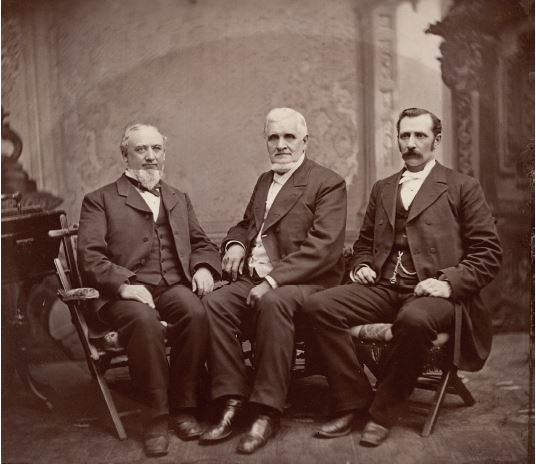 John Taylor, Church President, with his counselors, George Q. Cannon (left) and Joseph F. Smith (right), 1880. John Taylor was an 1836 convert to the Church in Toronto, and his second counselor, Joseph F. Smith, was the son of Canadian convert Mary Fielding. The 1880 First Presidency, with two members having a strong Canadian connection, is an example of how Canadians made significant contributions to the growth of the Church, from the earliest period. (Intellectual Reserve, Inc. [hereafter IRI])
John Taylor, Church President, with his counselors, George Q. Cannon (left) and Joseph F. Smith (right), 1880. John Taylor was an 1836 convert to the Church in Toronto, and his second counselor, Joseph F. Smith, was the son of Canadian convert Mary Fielding. The 1880 First Presidency, with two members having a strong Canadian connection, is an example of how Canadians made significant contributions to the growth of the Church, from the earliest period. (Intellectual Reserve, Inc. [hereafter IRI])
Canadian Mormons have contributed in significant ways to the Church, to Canada, and to the world at large. Prominent Latter-day Saints were born in Canada, have joined the Church in Canada, or have lived in Canada for a significant period of time, from the early days of the Church to the present. Although this chapter does not claim to provide a comprehensive and inclusive list of all such Canadians, it gives representative examples of extraordinary Canadian Mormons who have left their mark in Church leadership, agriculture, politics, business, the professions, and the arts—who made their world a better place. It will also assess the collective contribution of Canadian Mormons to Canada in terms of lifestyle, community service, and support of moral and ethical issues.[1]
Early Converts
In the early days of the Restoration, missionary work spread into Canada. An estimated 2,500 Canadians joined the Church between 1832 and 1855. Most of these left Canada to join the main body of the Church in the United States, where the Canadian converts went on to make meaningful contributions to the Church. From the numerical standpoint alone, 2,500 people, most of whom gathered to the main body of the Church, greatly swelled the membership of the Church. In the period prior to the large-scale conversions in the British Isles and their immigration to the United States, the body of Canadian converts comprised perhaps 7–8 percent of the total Church membership. Without these Canadians, the Church and its history and development would look quite different. A few of these prominent early converts are mentioned here. Some are well known; others are less so. All have nonetheless made remarkable contributions.
Converts from the Toronto Area and Southwestern Ontario
From the efforts of Parley P. Pratt and other missionaries in the Toronto area and southwestern Ontario, several branches were organized. Prominent Church leaders emerged from this group, contributing much to the growth of the Church.
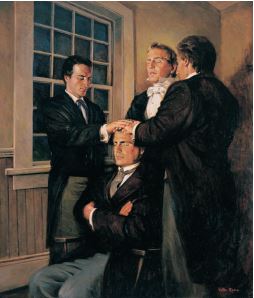 Parley P. Pratt was ordained an Apostle by Joseph Smith, Oliver Cowdery, and David Whitmer in 1835. The following year, Pratt began his mission to Toronto, where he converted a number of people who would become important leaders in the Church. (IRI)
Parley P. Pratt was ordained an Apostle by Joseph Smith, Oliver Cowdery, and David Whitmer in 1835. The following year, Pratt began his mission to Toronto, where he converted a number of people who would become important leaders in the Church. (IRI)
John Taylor emigrated from England to Toronto, Upper Canada (now Ontario), in 1832. Although affiliated with the Methodist Church, he became increasingly dissatisfied with the doctrines and practices of contemporary religions. When Parley P. Pratt taught him of a church with modern apostles and prophets and a restoration of New Testament Christianity and divine priesthood authority, John and his wife, Leonora, were baptized on 9 May 1836, after three weeks of intensive investigation. John Taylor soon became a leader over the various branches in the Toronto area. After Taylor and his family moved to Far West, Missouri, he was ordained a member of the Quorum of the Twelve in December 1838.[2] In the years that followed, Taylor and his family experienced harsh persecution, but his faith never wavered. In 1839, he accompanied several members of the Twelve to England, where he had great success preaching, delivering a series of lectures on the Restoration in large public halls and introducing the gospel to the Isle of Man. Returning to Nauvoo in 1841, he became editor of the Times and Seasons. He continued to be a powerful defender of the faith, always completely loyal to the Prophet Joseph Smith. He was with Joseph Smith in Carthage on 27 June 1844, when the Prophet and his brother Hyrum were martyred. Taylor was seriously wounded in the attack but survived and recovered. He was appointed to head a mission in France in 1849, where he helped translate the Book of Mormon into French. He later supervised missionaries in the eastern United States. After the death of Brigham Young in 1877, Taylor became the third President of the Church, serving until his death in 1887.[3] John Taylor’s son, John W. Taylor, became an Apostle and played a significant role in the settlement of Mormons in southern Alberta.[4]
Joseph Fielding (1797–1863) and two of his sisters, Mary (1801–52) and Mercy (1807–93), emigrated from England to Canada in the early 1830s, settling near Toronto. When Parley P. Pratt came there to preach in May 1836, the Fieldings felt the “Spirit and Power of God”[5] and were baptized on 21 May 1836.[6] Joseph Fielding felt a strong desire to share his new religion with the people of England.[7] By July 1837, he was on a ship to England, where he and six others, including Willard Richards and two Apostles, Heber C. Kimball and Orson Hyde, opened that land to the preaching of the gospel. Upon arriving in Liverpool, England, the missionaries travelled to Preston, where Joseph’s brother James was a Methodist minister. Joseph had previously written to his brother, which prepared the way for the missionaries to preach to his congregation. Joseph Fielding’s contacts with family members and acquaintances in England were instrumental in the success of the initial missionary effort.[8] Before the Apostles left England in April 1838, they appointed Joseph Fielding as president of the British Mission.[9]
Mary Fielding, after moving to Kirtland in May 1837, married Hyrum Smith, brother of the Prophet Joseph Smith, in December of that year and assumed the role of mother to Hyrum’s five motherless children. Mary’s first child, Joseph F. Smith, was born in November 1838 in Far West, Missouri, while her husband was imprisoned in Liberty Jail. Mary and her family were living in Nauvoo in June 1844, when Hyrum and his brother Joseph were martyred in Carthage, Illinois. This left Mary a widow with six children to care for. By her “indefatigable exertions,” she was able to provide for her family and transport them across the plains to Utah in 1848. Her example of faith, courage, and perseverance in overcoming adversity has inspired generations of Church members. She died in 1852 in Salt Lake City.[10] Her son, Joseph F. Smith, later became the sixth President of the Church in 1901, and his son, Joseph Fielding Smith, became the tenth Church President in 1970.[11] In addition to being the mother and grandmother of two Church Presidents, Mary Fielding Smith was also the grandmother of Hyrum Mack Smith and an ancestor of M. Russell Ballard, both of whom were members of the Quorum of the Twelve.[12]
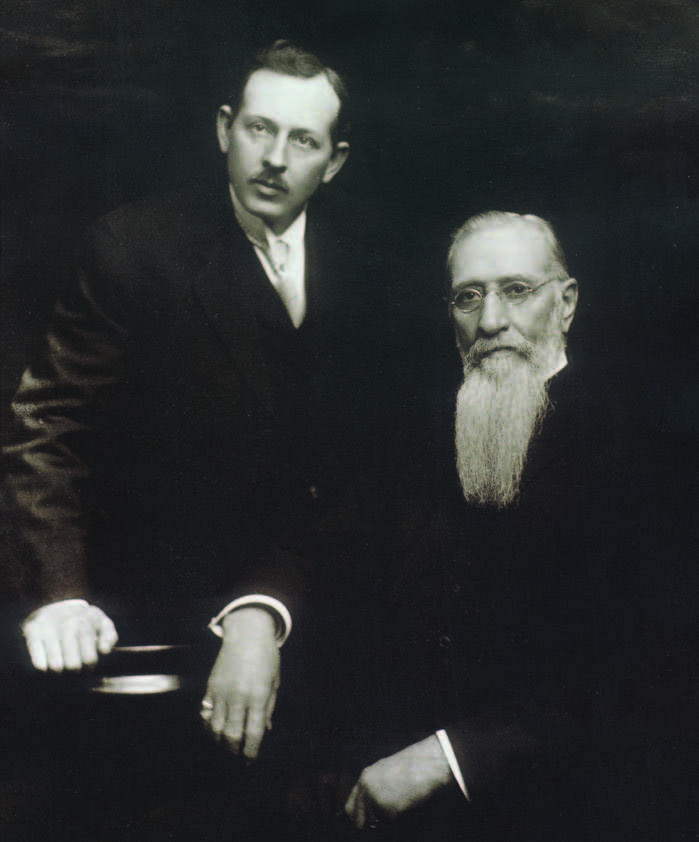 Joseph F. Smith, President of the Church, son of Canadian convert Mary Fielding, with his son, future Church President Joseph Fielding Smith. (IRI)
Joseph F. Smith, President of the Church, son of Canadian convert Mary Fielding, with his son, future Church President Joseph Fielding Smith. (IRI)
In June 1837, after moving to Kirtland, Mercy Fielding married a fellow Toronto convert, Robert B. Thompson. The newly married couple immediately returned to the Toronto area as missionaries, where they served until March 1838.[13] From Toronto, the couple went to Missouri, where they suffered extreme hardships and persecutions. Mercy’s husband, Robert, died in 1841, leaving her a widow with a young child. Mercy led an initiative in Nauvoo for women to contribute one cent per week for purchasing nails and glass for the Nauvoo Temple. This effort succeeded in raising five hundred dollars for that purpose. Before departing from Nauvoo to go west, Mercy was assigned by Brigham Young to work in the temple as an ordinance worker, which she did “night and Day.”[14] She crossed the plains to Utah in 1847 and until her death in 1893 was known for her faithfulness and generosity, contributing much money to the Perpetual Emigrating Fund and for temple construction.[15]
Archibald Gardner (1815–1902), an immigrant from Scotland, built two gristmills and a sawmill in Lambton County, Upper Canada, 260 kilometres southwest of Toronto, providing much-needed services to his pioneer community, as the gristmill was the only mill within fifty miles.[16] He was baptized in 1845, by which time most of the extended Gardner family had also joined the Church, and the small Warwick Branch was organized. In 1846, when the family received word that the Saints in Nauvoo were preparing to leave for the West, Archibald sold his mills and other property, as did his other family members, at far less than their value, to leave at once to join the departing Saints.[17] In their haste to leave, the family cut a six-mile road through heavily wooded bush country to connect with a main road, thus avoiding a hundred miles of extra travel by existing roads.[18] The Gardner families journeyed on to Nauvoo, and from there to Utah, where they contributed greatly to the settlement there.[19] The Gardner brothers built mills in Utah and Wyoming, again providing a much-needed service to the new settlers.[20] Archibald Gardner was appointed bishop of the West Jordan Ward in 1858 and served for thirty-two years.[21] In 1946, one hundred years after the Gardner family carved their six-mile road through the wilderness, that section of Ontario highway was officially designated the “Nauvoo Road.”[22]
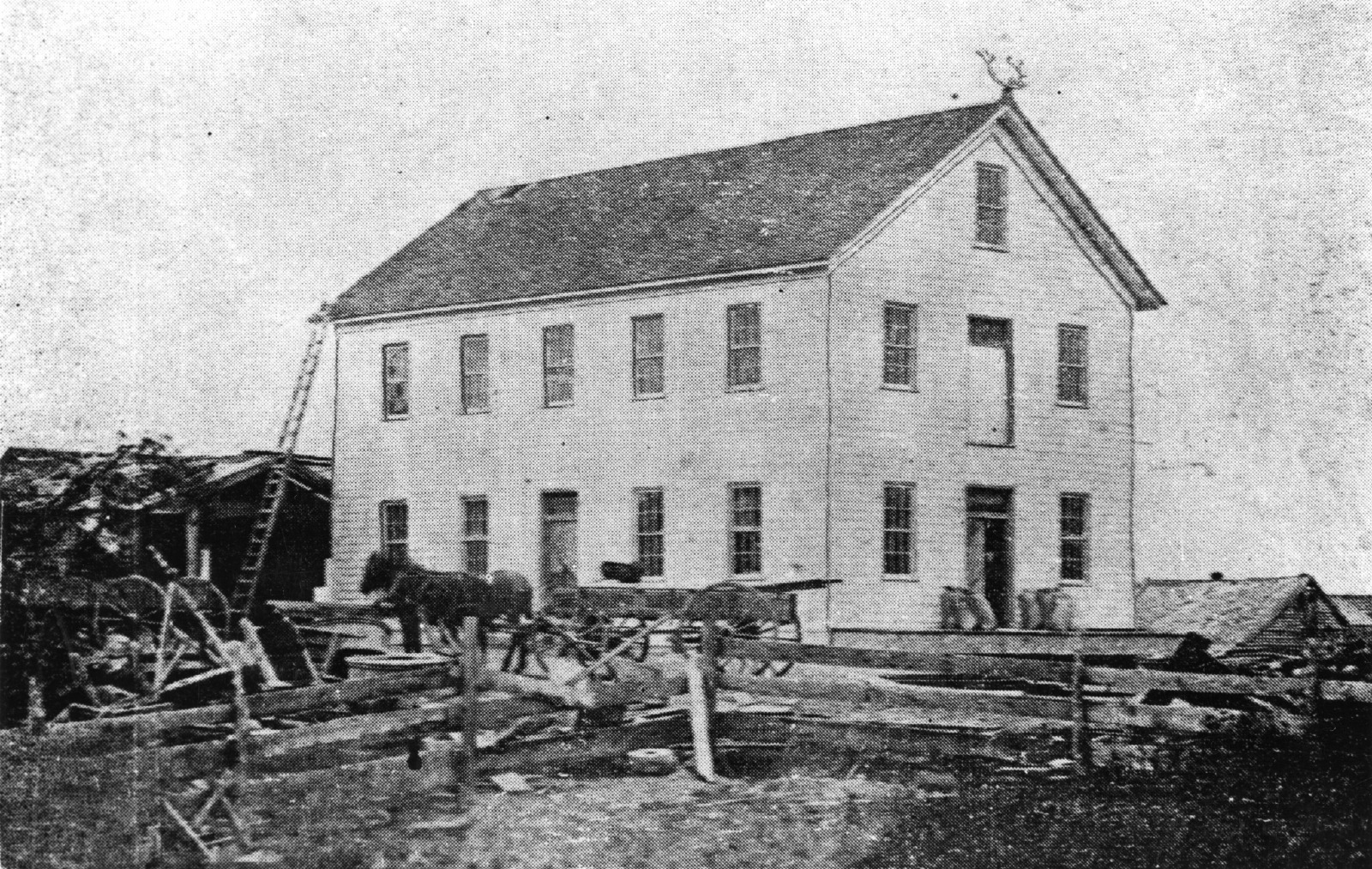 Gardner Mill in West Jordan, Utah, 1880, one of more than 30 that Archibald Gardner built in his lifetime. Gardner, who joined the Church in Upper Canada in 1845, built mills in the Salt Lake Valley and other areas, including a flour mill in West Jordan in 1853. On the site of the original mill now stands Gardner Village, a charming grouping of specialty stores in an historic setting. The mill is currently listed on the National Historic Register. Gardner also helped to develop the irrigation canal system in the area.[23] (Utah State Historical Society)
Gardner Mill in West Jordan, Utah, 1880, one of more than 30 that Archibald Gardner built in his lifetime. Gardner, who joined the Church in Upper Canada in 1845, built mills in the Salt Lake Valley and other areas, including a flour mill in West Jordan in 1853. On the site of the original mill now stands Gardner Village, a charming grouping of specialty stores in an historic setting. The mill is currently listed on the National Historic Register. Gardner also helped to develop the irrigation canal system in the area.[23] (Utah State Historical Society)
Joseph (1812–97) and Isabella (1818–1906) Horne, both immigrants from England, were baptized in Toronto in July 1836.[24] Isabella invited her parents, Stephen and Mary Ann Hales, to attend a Church meeting, and soon their large family also joined the Church.[25] When the Prophet Joseph Smith and other leaders visited the Toronto area in August 1837, the Hornes hosted the visitors in their home and escorted them to meet with Church members in various branches.[26] Isabella later recorded her feelings the first time she met the Prophet Joseph: “When I first shook hands with him I was thrilled through and through and I knew that he was a Prophet of God, and that testimony has never left me.”[27] The Horne and Hales families experienced mob violence and privation in Missouri, were driven to Illinois, and in due course crossed the plains to Utah in 1847. Joseph and Isabella settled in Salt Lake City, where they raised their large family. They became the parents of fifteen children, including three sets of twins. In the following years, Joseph Horne was assigned to explore certain areas of Utah, served as a member of the Salt Lake City Council, worked on the temple, and later served as a patriarch.[28] Isabella was president of the Fourteenth Ward Relief Society for fourteen years, and she also served many years as president of the Salt Lake Stake Relief Society. In 1880, she was appointed treasurer of the Central Board of Relief Society, which later became the Relief Society general board, and continued in that office until 1901. She also served for twelve years on the Deseret Hospital Committee and was prominent in the establishment of the silk industry in Utah.[29]
Theodore Turley (1800–71) emigrated from England to Canada in 1825, settling in Churchville, near Toronto. In early 1837, he heard and accepted the gospel, was baptized, and served successfully as a local missionary until departing for Missouri in 1838. In Missouri, the Turley family participated in the hardships and struggles of the Saints during that period. Turley was on the committee to assist the destitute Saints to move from the state. The committee formed for that purpose met regularly in the Turley home.[30] In 1839, Turley embarked on a mission to England, with several members of the Quorum of the Twelve.[31] Richard E. Turley, managing director of the Public Affairs Department and formerly assistant Church historian and recorder, is a descendant of Theodore Turley.
Another prominent Canadian, Robert T. Burton, a convert from southwestern Ontario, served as a member of the Presiding Bishopric from 1874 to 1907.[32]
The Role of Canadians in Taking the Gospel to the British Isles
Heber C. Kimball, in giving a priesthood blessing, prophesied in April 1836 that Parley P. Pratt would serve a mission to Toronto and that the gospel would be taken to England as a result of that mission. The following year, July 1837, when Heber C. Kimball, Orson Hyde, and Willard Richards departed for the first mission to the British Isles in, they took with them four men who had been converted in Toronto by Pratt and his associates—Joseph Fielding, Isaac Russell, John Goodson, and John Snider. After arriving in Liverpool, the missionaries promptly travelled thirty-one miles north to Preston, where Joseph Fielding’s brother James and other family members lived. James Fielding, a Methodist minister, initially welcomed the missionaries, allowing them to preach in his chapel. The missionaries preached to large and interested congregations, and within a week, the first converts were baptized. From their base in Preston, the missionaries spread out to neighbouring towns, finding great success. By the time the Apostles left England in April 1838, there were already 1,500 converts there. They had truly established a foothold for the Church in England.[33]
Many missionaries soon followed, with eight Apostles serving in England from 1839 to 1841, including Toronto convert John Taylor. The expanding missionary force also included another Canadian convert, Theodore Turley. Thousands of British converts resulted, many in due course emigrating from England to Nauvoo.[34]
In 1839, two other Toronto-area converts, Alexander Wright and Samuel Mulliner, were the first to take the gospel to Scotland.[35] Wright and Mulliner, both born in Scotland, returned to their native land in December 1839. They began by visiting family and acquaintances and expanded their missionary efforts from there. They baptized their first converts in January 1840.[36] In early May 1840, Orson Hyde of the Quorum of the Twelve joined Wright and Mulliner in Scotland and organized the first Scottish branch in Paisley on 17 May. By that date, there were 80 Scottish converts.[37]
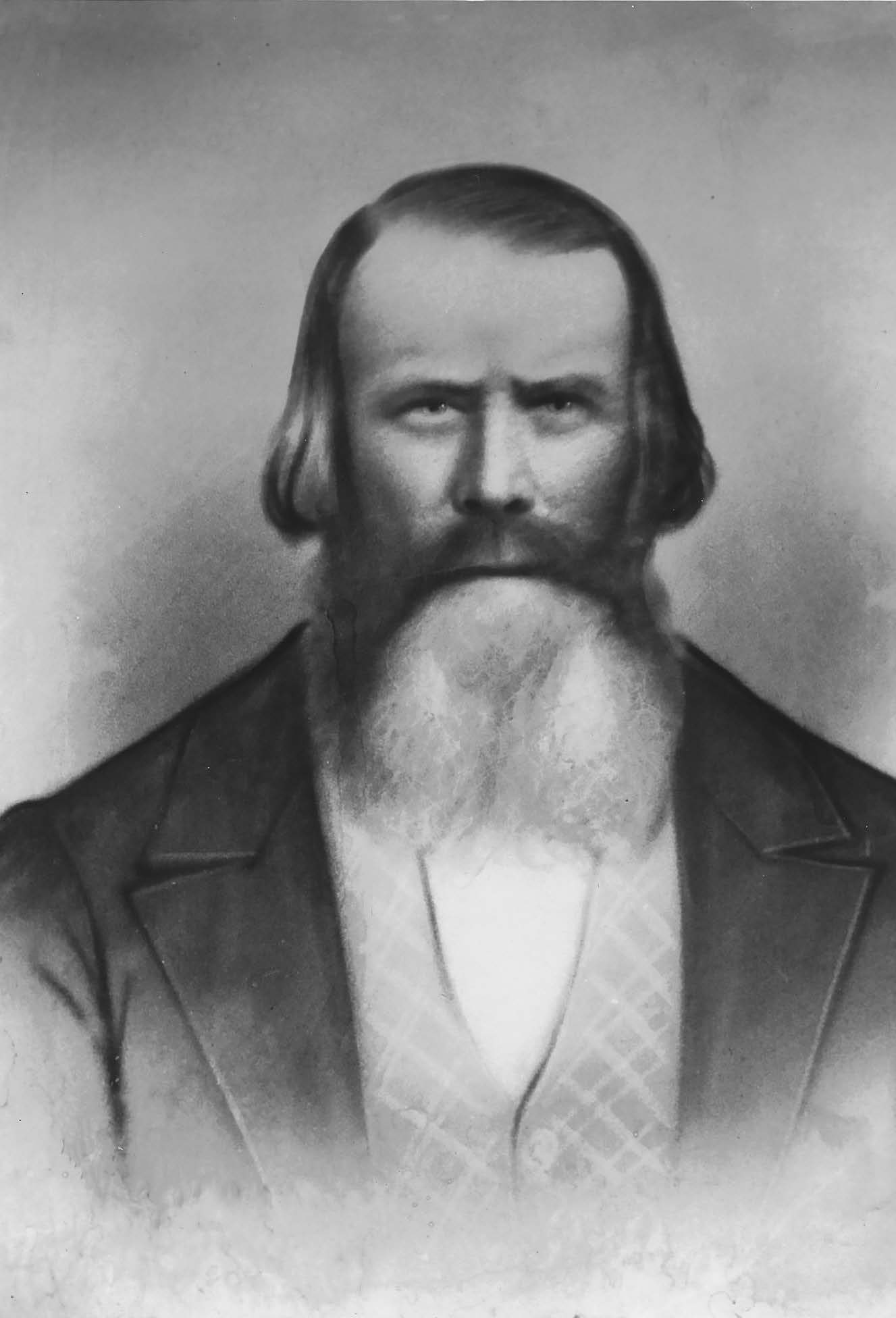 Alexander Wright. He and Samuel Mulliner, converted to the Church in the Toronto area, returned to their native Scotland in 1839 and were the first missionaries to bring the gospel to that land. (IRI)
Alexander Wright. He and Samuel Mulliner, converted to the Church in the Toronto area, returned to their native Scotland in 1839 and were the first missionaries to bring the gospel to that land. (IRI)
Converts from the Kingston-Leeds Area in Upper Canada
Although a number of prominent converts were made in Toronto and western Ontario, an even larger number of people were converted in the areas of Kingston, along the Rideau Canal, and into eastern Ontario, through the missionary work of Brigham Young, John E. Page, and others. The bulk of these converts left Canada by 1838 to join the main body of the Saints, greatly swelling the ranks of the Church, going on to contribute greatly, individually and collectively, to the building up of the settlement of the Intermountain West.
Artemus Millet, an 1833 convert from Ernestown, Upper Canada, was an experienced builder and stonemason. He had constructed buildings, bridges, chimneys, and foundations and had done work for the British Army. After his baptism, Millet received a letter from Hyrum Smith telling him that the Lord needed him to come to Kirtland to work on the temple.[38] There, he put his building experience to good use, where he played a significant role in the construction of the Kirtland Temple.[39]
Ira Nathaniel Hinckley was born in Leeds County, Upper Canada, in 1828 and heard the gospel as a child when a missionary, John E. Page, taught members of the Judd and Hinckley families in 1836, all of whom in due course joined the Church. Ira travelled with many members of his extended family in 1838 to join the Saints in the United States. In Nauvoo, Hinckley learned the trade of blacksmithing and was known for his expertise in a variety of frontier survival skills.[40] In Utah, his skills and abilities were called upon, as he helped excavate for the construction of the Salt Lake Temple, built protective forts along the mail and telegraph routes in Wyoming, and supervised the construction of an LDS meetinghouse in Coalville.[41]
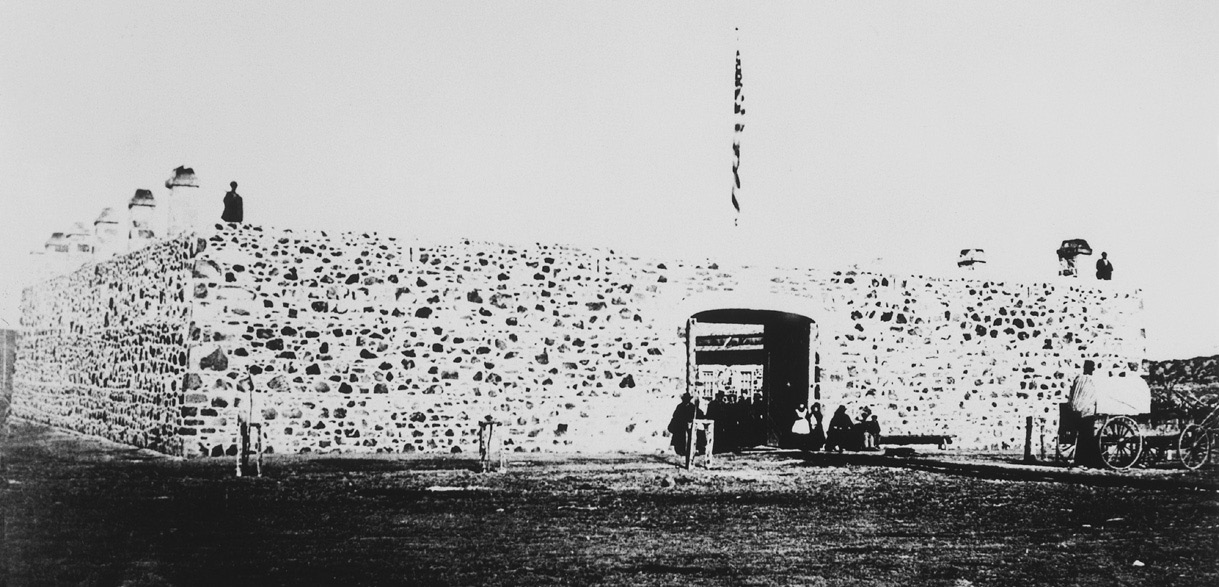 Ira Nathaniel Hinckley, who as a child heard the gospel in Canada in 1836, traveled with his family to join the main body of the Saints. He acquired important frontier skills and supervised the construction of Cove Fort in 1867. (IRI)
Ira Nathaniel Hinckley, who as a child heard the gospel in Canada in 1836, traveled with his family to join the main body of the Saints. He acquired important frontier skills and supervised the construction of Cove Fort in 1867. (IRI)
On 12 April 1867, Hinckley received a letter from Brigham Young inviting him to build a fort at Cove Creek, south of Fillmore, and to supervise the Church ranch there. President Young wrote that, because Cove Creek “is some distance from any other settlement, a man of sound practical judgment and experience is needed to fill this place.”[42] Ira responded to the call promptly. By 27 April he arrived at Cove Creek and began construction of the fort at once. Using available black volcanic rock and timber, Hinckley and his crew completed the sturdy fort by November 1867.[43] Cove Fort consisted of four walls eighteen feet high, enclosing a courtyard one hundred feet on each side, with stout wooden doors and gates.[44] In 1877, Hinckley was called to be the first president of the Millard Stake, with headquarters in Fillmore. For more than twenty-five years, he served faithfully in this calling, travelling extensively to carry out his responsibilities in the geographically large stake, often on very poor roads. He also served a term as mayor of Fillmore.[45] His grandson, Gordon B. Hinckley, became the fifteenth President of the Church.[46]
Jane Snyder Richards (1823–1912) and her family first heard the gospel preached by John E. Page in 1837 in Camden, Ontario. Jane’s parents and most of her siblings were baptized, but Jane did not accept the gospel until 1840, after her family had left Canada to join the main body of Saints. Her conversion and baptism coincided with her miraculous healing, when she was carried from what was believed to be her deathbed and baptized through a hole in the ice.[47] Jane married Franklin Dewey Richards in Nauvoo in 1842. Her two young children died as she was crossing Iowa in 1846, while Franklin was serving a mission in England. When Franklin returned from England, he and Jane crossed the plains to Utah in 1848, where four more children were born to the couple between 1849 and 1859. Franklin was ordained an Apostle in 1849. In addition to providing for the needs of her family and supporting her husband in his Church service, Jane held positions of great responsibility in the Relief Society, including thirty-one years (1877–1908) as president of the stake Relief Society in Ogden and thirteen years (1888–1901) as first counselor in the Relief Society General Presidency. She was a Utah delegate to the National Council of Women and was known for her personal ministrations to the sick and needy. It was written of her, “She honored and dignified every position she occupied, and faithfully performed the many important and responsible public duties which devolved upon her.”[48]
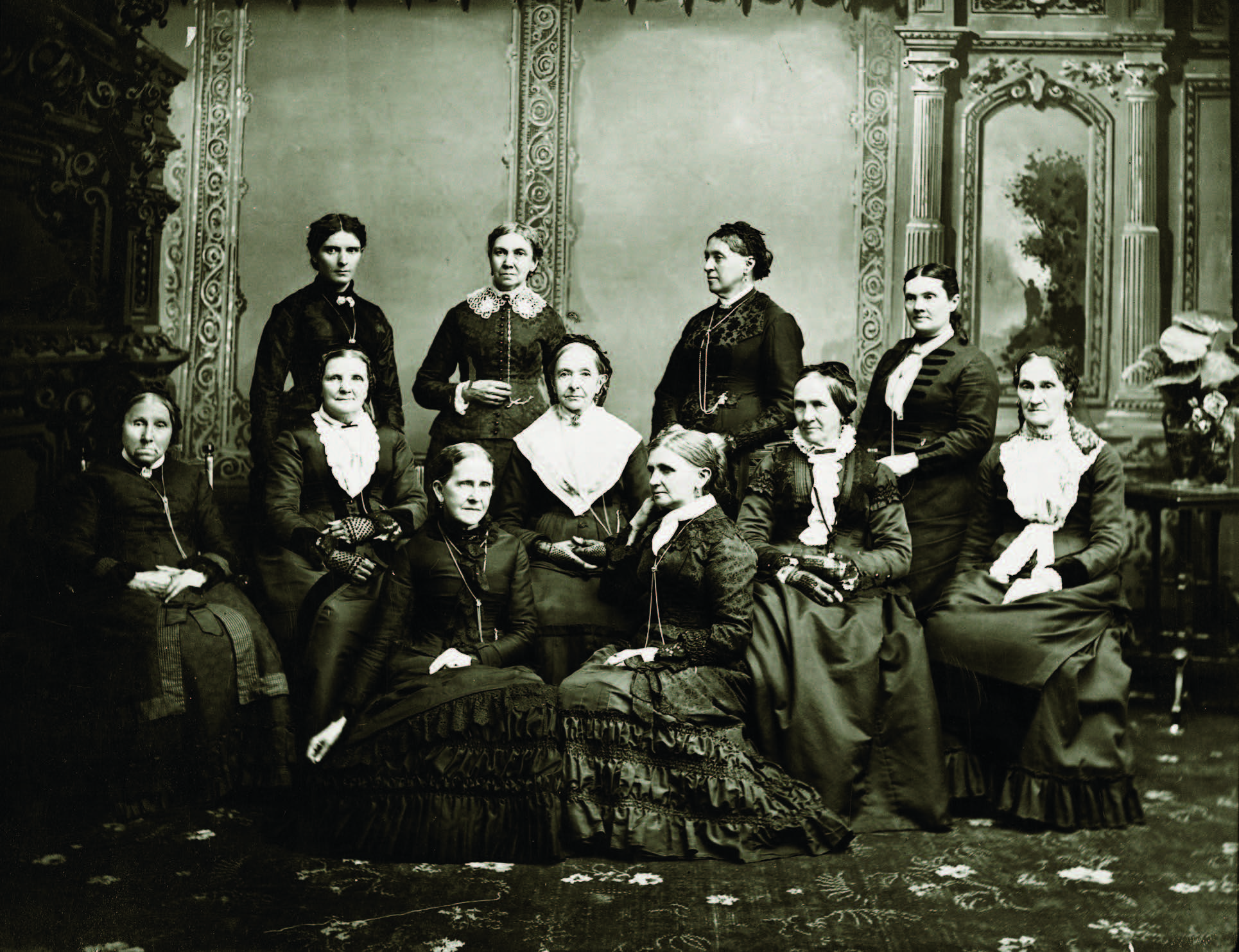 The Deseret Hospital Board of Directors, circa 1882 to 1884, included some of the most prominent Latter-day Saint women in the Utah Territory at the time. Front row, left to right: Jane Snyder Richards, Emmeline B. Wells; second row, left to right: Phebe Woodruff, Mary Isabella Horne, Eliza R. Snow, Zina D. H. Young, Nancy M. J. Hyde; back row, left to right: Dr. Ellis R. Shipp, Bathsheba W. Smith, Elizabeth A. Howard, Dr. Romania B. Pratt. Two of these women, Jane Snyder Richards and Mary Isabella Horne, came from Canada. (IRI)
The Deseret Hospital Board of Directors, circa 1882 to 1884, included some of the most prominent Latter-day Saint women in the Utah Territory at the time. Front row, left to right: Jane Snyder Richards, Emmeline B. Wells; second row, left to right: Phebe Woodruff, Mary Isabella Horne, Eliza R. Snow, Zina D. H. Young, Nancy M. J. Hyde; back row, left to right: Dr. Ellis R. Shipp, Bathsheba W. Smith, Elizabeth A. Howard, Dr. Romania B. Pratt. Two of these women, Jane Snyder Richards and Mary Isabella Horne, came from Canada. (IRI)
James Lake, who lived in Ernestown (about twenty kilometres west of Kingston), Upper Canada, was the son of a United Empire Loyalist who settled in Canada after the Revolutionary War. One of the first converts to the LDS Church in Canada, Lake brought his large family from Kingston to Kirtland in 1833 in a company led by Brigham Young. In spite of his disability, having lost a leg in an accident, James assisted in building the Kirtland Temple. In Council Bluffs, Iowa, while preparing to cross the plains, he was called as a bishop, with responsibility to provide for the poor and needy. He was captain of a wagon train that crossed the plains to Utah in 1850, settling in Ogden. When the first city council was organized in Ogden in 1851, Lake was a member of that council. In 1853, he was called to be patriarch of the Weber Stake and served for many years.[49]
Other Canadian converts went on to provide labour, expertise, and leadership as the Church established itself in the Intermountain West. Daniel Wood, an 1833 Kingston-area convert, was one of the first settlers in Bountiful, Utah, and the community of Woods Cross is named after him. Henry D. Moyle, a member of the Quorum of the Twelve from 1947 to 1959 and a counselor to Church President David O. McKay from 1957 to 1963, descended from Daniel Wood.[50] The town of Draper was named for William Draper Jr., the first Church leader in the community, who, like Daniel Wood, had been baptized in the Kingston area in 1833.[51] The first people to settle the town of American Fork were Arza Adams and Stephen Chipman, who had been baptized in Leeds County, Upper Canada, in the 1830s.[52] Margaret Gay Judd, whose parents joined the Church in Leeds County, Upper Canada, in 1836, when Margaret was a young child, became the mother of Rudger Clawson, who served from 1921 to 1943 as President of the Quorum of the Twelve.[53]
Converts from Eastern Canada
Although there were fewer converts in Quebec and the Maritime Provinces than in Upper Canada, there were nevertheless a significant number of people who joined the Church in the eastern part of Canada who contributed to the progress of the Church.
Sarah Sturtevant Leavitt, living with her husband and children in Lower Canada (Quebec), learned about the restored gospel in 1835 from her husband’s sister, who had previously met with missionaries and been baptized. After studying the Book of Mormon and the Book of Commandments, which her sister-in-law had shared with her, Sarah immediately recognized this as the religion she had been seeking and set out for Kirtland with her husband, children, and several members of the extended Leavitt family. In Kirtland, Sarah and some other family members were baptized.[54] A woman of extraordinary faith, Sarah recorded participating in miraculous healings and receiving visions and dreams. She showed remarkable resilience in the face of persecutions and hardships. After her husband, Jeremiah, died in August 1846, Sarah and her family continued to Utah, where she eventually settled in the Santa Clara area in southern Utah.[55] There she lived for twenty-two years, where she helped “in taming the southern Utah desert into a habitable place,” and where, “always firm in her cherished faith, she became a matriarch among the pioneer women, helping to teach them the skills of self-reliance and survival on the harsh frontier, standing as an example of stalwart strength.”[56] A monument in Sarah’s honour was unveiled in Santa Clara in 1998 on her two hundredth birthday.[57] (See photo of monument in chapter 2.) It was believed that her posterity was among the largest in the Church.[58] One of her sons, Thomas Rowell Leavitt, and his large family were early Latter-day Saint settlers in southern Alberta, and the town of Leavitt was named for them.[59]
Marriner W. Merrill was born in Sackville, New Brunswick, in 1832, where he was baptized twenty years later.[60] In April 1853, Merrill departed from New Brunswick, in company with other Canadian converts, and arrived in Salt Lake City in September.[61] In November 1853, Merrill married Sarah Ann Atkinson, the daughter of his Sackville branch president.[62] Merrill and his family moved to Richmond, Utah, in 1860, where he soon became a leader in the Church and in the community. He was bishop for eighteen years, served as postmaster, was elected twice to the territorial legislature, and was much involved in building railroads, roads, canals, and schools. Although very limited in his formal education, he proved very successful in his various ventures, helping to build a sugar beet factory and one of the first creameries in Utah. In 1866, he and others established the Richmond Cooperative Mercantile Company, one of the first cooperative stores in Utah. He was for a number of years on the board of trustees of the Brigham Young College in Logan. In 1884, he became president of the Logan Temple. In 1889, he was called as a member of the Quorum of the Twelve. He served concurrently as temple president and member of the Quorum of the Twelve from 1889 until his death in 1906, and between 1899 and 1901 he was also president of the Cache Stake.[63] His son Joseph F. Merrill also became an Apostle.[64]
Joseph Russell was born in Scotland, settled in Chatham, New Brunswick, near Miramichi, and soon became a leading citizen. He established a successful shipbuilding industry on Beaubears Island, where he built a total of twenty-six large oceangoing ships between 1836 and 1850. When he and his wife, Agnes, were baptized as members of The Church of Jesus Christ of Latter-day Saints in about 1842, their neighbours reacted with persecution, harassment, and mob violence. It no doubt was difficult for Russell to be treated so badly in a town where he had once been such a prominent and well-respected citizen.[65] Russell constructed a small chapel on his property and was the presiding elder of the small congregation of Latter-day Saints in the area. Wilford Woodruff visited the Russells in 1849 and was very impressed with their kindness and hospitality and with the way Russell conducted his Church meetings and his business affairs.[66]
In 1850, Joseph Russell sold Beaubears Island, his shipyard, and his ships—preparing to move his family to Utah by way of England—to settle his business affairs. In England, he was encouraged by John Taylor to pioneer the sugar beet industry in Utah. In 1851, Russell, with his substantial wealth, became the principal investor in the Deseret Manufacturing Company, which was intended to manufacture sugar from sugar beets. A large quantity of the best sugar beet seeds was purchased in France and sent to Utah in time for spring planting in 1852, and wrought iron machinery was manufactured in Liverpool and shipped to New Orleans and then on to Fort Leavenworth, Kansas, via riverboats. Meanwhile, Joseph Russell arrived in Kanesville, Iowa, and had fifty-two wagons constructed to transport the machinery across the plains to Utah. However, the wagons proved to be too lightweight to carry the heavy equipment. Russell donated his fifty-two wagons to poor Saints headed for Utah and was obliged to purchase forty heavy Santa Fe freight wagons to move the machinery to Utah. The journey west was plagued with additional mishaps and unexpected expenses. Once the machinery arrived in Utah, it was ultimately assembled in an area in the Salt Lake Valley still known as Sugar House, but the machinery was defective and was unsuccessful in producing sugar. Russell’s considerable investment was lost. Some years later, in the 1890s, sugar from sugar beets was successfully produced in Utah when a better technology was developed.[67]
Russell died in Salt Lake City in 1855, leaving no wealth or business empire. But he had shown himself to be a man of “high principles” and “remarkable business ability,” widely respected in civic and religious circles.[68] A plaque honouring Joseph Russell was dedicated on 16 October 2005 on Beaubears Island. The plaque, jointly placed by Parks Canada in Kouchibouguac National Park, the Mormon Historic Sites Foundation, the city of Miramichi, and the Friends of Beaubears Island, described Russell as a “master shipbuilder and exemplary resident both of the United States and Canada.”[69]
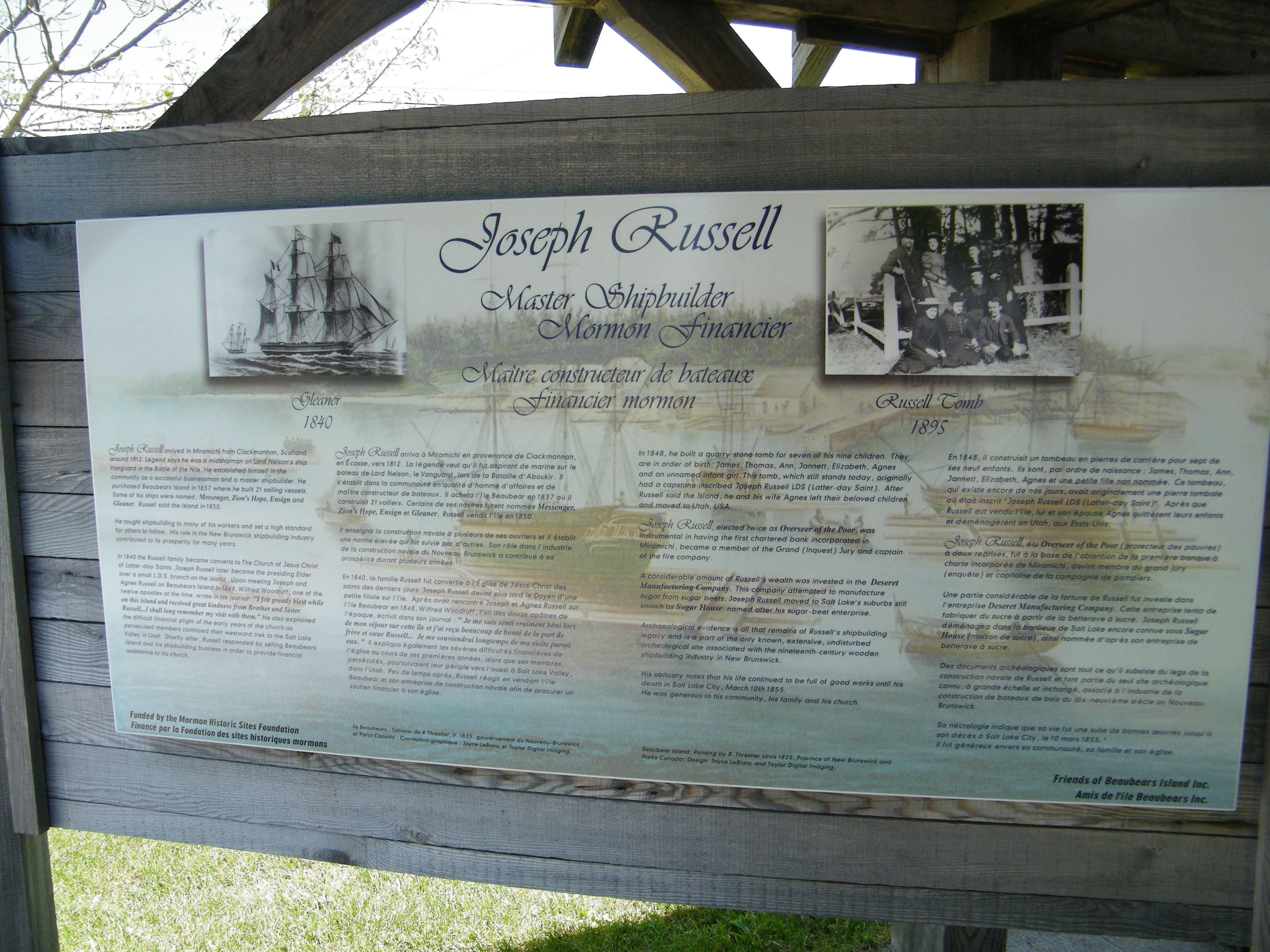 Joseph Russell, a successful New Brunswick shipbuilder, was converted to the Church in 1840 or 1841. He generously imparted most of his considerable wealth to the Church and enterprises associated with the betterment of Church members. His contribution to Canada and to the Church was honoured in 2005 with a historic panel placed on Beaubears Island near Miramichi, New Brunswick. (Shawn McCarthy)
Joseph Russell, a successful New Brunswick shipbuilder, was converted to the Church in 1840 or 1841. He generously imparted most of his considerable wealth to the Church and enterprises associated with the betterment of Church members. His contribution to Canada and to the Church was honoured in 2005 with a historic panel placed on Beaubears Island near Miramichi, New Brunswick. (Shawn McCarthy)
Mormon Settlements in Alberta: Contribution to Agriculture
Captain John Palliser, a nineteenth-century explorer, after a three-year expedition to western Canada in 1857–60, described a large area in southern Alberta and southwestern Saskatchewan, which came to be known as the Palliser Triangle, as unsuitable for farming because of its arid climate.[70] But the unfavourable designation did not discourage the hardy Mormon settlers who arrived in southern Alberta beginning in 1887. An even more arid region, Utah had been deemed unsuitable for settlement prior to the Mormons’ arrival there in 1847, but with hard work and the introduction of irrigation, agriculture had become successful. Charles O. Card, before coming to Canada, had been heavily involved in three major irrigation projects in Cache Valley, Utah. He had confidence that introducing irrigation to southern Alberta would be equally successful. Working with Charles A. Magrath, a non-Mormon railway magnate and landholder, and with the President of the LDS Church, Card spearheaded an effort to recruit large numbers of men from Utah, many of whom were unemployed, to come to Alberta to help build canals. These men were paid partly in cash and partly in land, so many of the canal workers stayed in Canada as settlers. There followed extensive canal-building projects, bringing life-giving water to an expanding area of farms.[71]
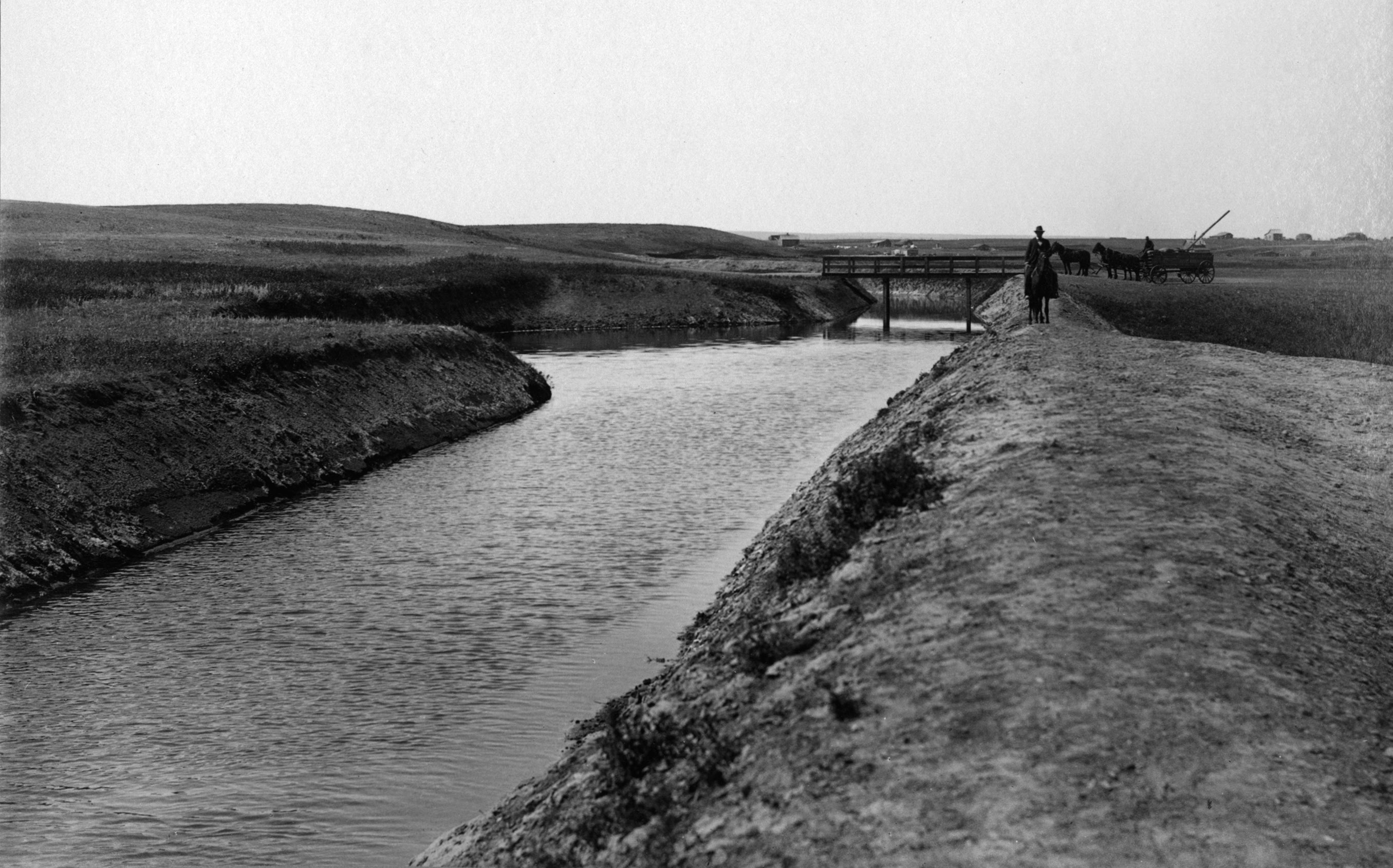 Mormon settlers in southern Alberta built a network of irrigation canals, making possible successful agriculture in the arid region. (IRI)
Mormon settlers in southern Alberta built a network of irrigation canals, making possible successful agriculture in the arid region. (IRI)
The introduction of irrigation to Canada has been deemed one of the major contributions of Mormons to their new land. Mormon settlers in southern Alberta, through irrigation farming, prospered in the arid environment of their new homeland.[72] Through the efforts of Latter-day Saints in building canals and introducing irrigation to southern Alberta, much land was opened to settlement in the Palliser Triangle. Were it not for the Latter-day Saint settlers establishing irrigation, the Palliser Triangle would undoubtedly have remained lightly settled ranch land.[73] In 2015, the vast majority of irrigated lands in Alberta were in the areas settled by Latter-day Saints.[74]
When Mormon settlers came to southern Alberta, they brought with them the practice of establishing agricultural villages so that residents could enjoy the benefits of community life, education, and Church participation while farming the outlying lands. These villages were laid out on the four points of the compass, modelled after the “Plat of Zion,” originated by Joseph Smith.[75] In recognition of the important and unique contribution of Latter-day Saint pioneers to the settlement of Alberta, Parks Canada designated the village of Stirling, Alberta, as a national historic site, the “best-preserved Canadian example of the distinctive settlement pattern known as a Mormon Agricultural Village.”[76]
Jesse Knight and Asael Palmer
Jesse Knight, a wealthy Church member from Utah and son of 1833 Canadian convert, Lydia Goldthwaite Bailey, introduced the sugar beet industry to southern Alberta. In 1901, he purchased large tracts of land between Magrath and Stirling and contracted with irrigation companies to build a sugar beet factory by 1903. An estimated 1,500 settlers arrived to purchase tracts of land, and the town of Raymond was born. E. P. Ellison was hired to oversee construction of the factory and manage its operation, and in 1903 there were Three thousand acres of sugar beets under cultivation. Although the enterprise looked promising, the farmers were inexperienced with raising sugar beets, and their new crop proved to be very labour intensive, requiring the importation of Asian workers. The factory in Raymond was able to produce good-quality sugar, but as the years went by, farmers decreased their sugar beet acreage in favour of other crops that required less work. After twelve years, with insufficient sugar beets being grown to supply the operation, the factory was closed and disassembled. Although the sugar beet enterprise had not been financially successful, it had brought many settlers to the area and had provided a giant boost to the economy. By the time the factory closed, the town of Raymond was well enough established and diversified that it remained a viable town. Jesse Knight, who had not expected the sugar factory to be a profitable commercial venture, was content to use his wealth for the long-term benefit of the Mormon settlers. In this, it was highly successful.[77] The sugar beet industry was revived in southern Alberta in 1925, and in 1950 a new factory was constructed in Taber, providing much employment and economic benefit to the area.[78]
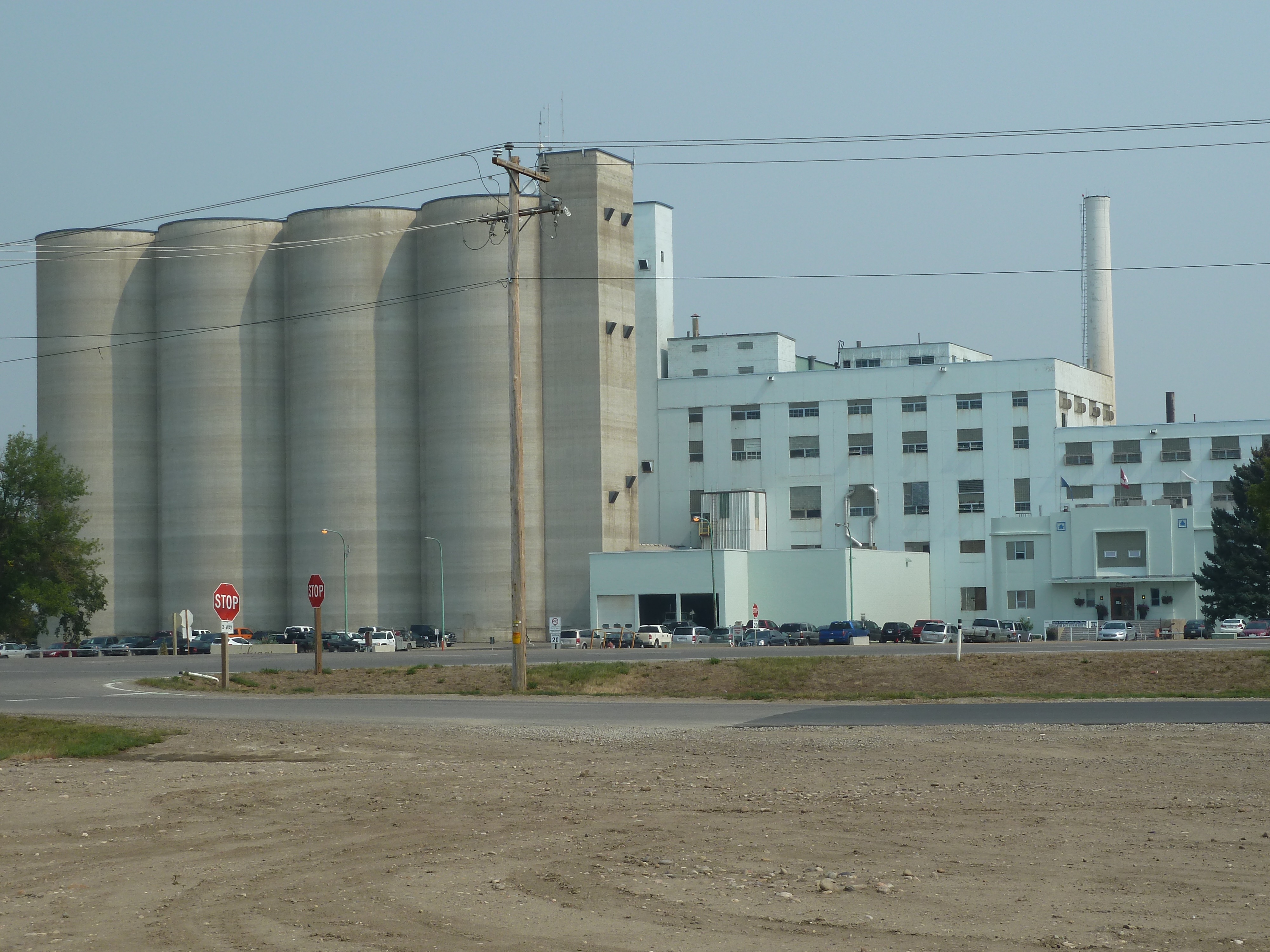 The sugar beet industry was an important part of successful agriculture in southern Alberta. The first sugar factory in Canada was built in Raymond in 1903. The photograph shows the sugar factory built in Taber in 1950, which has since played a significant role in the local economy. (Darrel Nelson)
The sugar beet industry was an important part of successful agriculture in southern Alberta. The first sugar factory in Canada was built in Raymond in 1903. The photograph shows the sugar factory built in Taber in 1950, which has since played a significant role in the local economy. (Darrel Nelson)
Asael Palmer was arguably the most important agriculturalist in the history of western Canada. Born in Utah, he came with his parents to southern Alberta in 1903 at the age of fifteen, where he helped on the family farm and later, with his brother, filed for a separate homestead. This practical experience was augmented by a bachelor’s degree from Utah State Agricultural College in 1917. He was employed to study soil chemistry in southern Alberta and evaluate lands in various areas for their suitability for irrigation. In 1921, he obtained a position at the Dominion Experimental Farm at Lethbridge, where he conducted numerous controlled experiments to determine the most effective methods of irrigating in different soil conditions. His findings were published and widely distributed.[79]
During the devastating nine-year drought of the 1930s, when vast areas of the North American plains became a “dust bowl,” Palmer’s expertise was focused on finding solutions to soil erosion. He studied the areas in southern Alberta that were experiencing soil drifting and set up experiments to determine which farming practices best held the soil in place. As a result of his insightful research, many farmers changed their farming methods and adopted his recommendations to leave stubble in the fields (trash-cover farming), to utilize strip farming, and to incorporate new methods of water conservation, such as basin listing, significantly ameliorating the effects of the drought. He continued throughout his life to be a highly respected international authority on irrigation and agricultural practices, as well as a dedicated Church leader, serving as president of the Lethbridge Stake for more than twenty years, from 1926 to 1947.[80]
As a part of the celebration of Alberta’s centennial in 2005, the Lethbridge Herald invited its readers to submit nominees for the most important southern Albertan in the past hundred years. More than seventy people were nominated, and the final selection was Asael Palmer.[81]
Other Leaders in Agriculture
Notable contributions to Canadian agriculture were made by other Latter-day Saints as well. Building on the Utah cooperative experience, Charles O. Asplund built a successful feeder operation, the Lethbridge Central Feeders Association, managing a network of ranchers and farmers, wherein the ranchers provided livestock, the farmers fed and cared for them, and the animals were shipped and marketed throughout North America.[82] Ephraim P. Ellison, who arrived in Raymond in 1902 to construct and manage the Knight Sugar Factory, also built the first grain elevator and flour mill in the area. The milling business was later expanded with mills in other locations, including Lethbridge and Magrath, and continued into the twenty-first century as the “last large wholly Canadian-owned milling company” in Alberta.[83] Large quantities of wheat from Ellison Milling were shipped to Europe after World War II to keep the German Saints from starvation.[84] Lavolee Rogers Jensen contributed significantly to the development of the sheep and wool industry in southern Alberta and provided leadership in the sugar beet industry.[85] In 1994, Kenneth F. Nielsen was awarded the Order of Canada for his work with the Canadian International Development Agency as an agricultural adviser in Africa, Asia, and the Caribbean. He introduced improved agricultural techniques which increased yields and earned the respect of farmers throughout the world.[86]
Church Leaders in the Modern Era
Canadian Connections
Canadian Latter-day Saints, because of the close proximity of Canada to the United States, have always enjoyed a close connection with Church leaders. The first four Church Presidents did missionary work in Canada. The Prophet Joseph Smith visited Canada twice—in 1833 and 1837. This was his only “foreign” mission. Prominent among the other missionaries serving in Canada in the 1830s and 1840s were Brigham Young and Wilford Woodruff, as well as John Taylor, who was converted there. Apostle Parley P. Pratt and future Apostle John E. Page made many converts in Canada. In more modern times, Thomas S. Monson served as president of the Canadian Mission from 1959 to 1962, prior to being called as a member of the Quorum of the Twelve in 1963. M. Russell Ballard likewise served as president of the Canada Toronto Mission from 1974 to 1977 prior to his call as a Seventy in 1976 and an Apostle in 1985. Tad R. Callister, formerly of the Presidency of the Seventy and called as Sunday School general president in 2014, served as president of the Canada Toronto East Mission from 2005 to 2008. Apostles Mark E. Petersen and Neal A. Maxwell, as well as distinguished LDS writer, speaker, and professor Truman G. Madsen, served as young missionaries in Canada.
Canadian Contribution to Church Leadership
Canadian Mormons have provided significant service and leadership to the Church, not only at the local and regional level but to the Church as a whole. A number of Canadians have served as General Authorities and General Officers of the Church, leaving a lasting impact on Church members throughout the world. The following are a few examples of these remarkable Canadians.
Nathan Eldon Tanner, the high school principal in Cardston, was elected a Member of the Legislative Assembly when the Social Credit Party decisively won the Alberta provincial election in 1935. Tanner’s only previous political involvement was a term on the Cardston City Council. Most of the newly elected MLAs were similarly inexperienced in government. Much to his surprise, Tanner was selected to be Speaker of the Assembly. Not only was he totally unfamiliar with parliamentary procedure, but he had never before even attended a session of the provincial legislature. But, in line with his approach to other challenges, he immediately set to work to correct his deficiency, diligently studying the rules and procedures so that he could fill his role properly and with dignity. The following year, Tanner was appointed to an important cabinet position, Minister of Lands and Mines. He immediately undertook an extensive study of oil, gas, and other natural resources and government policies concerning them in the United States and elsewhere, travelling and consulting with experts to prepare himself to formulate policies in Alberta which would “develop the natural resources for the benefit of the people as a whole.”[87]
After seventeen years of strong, effective, and honourable service to the province, Tanner retired from government service in 1952. He immediately entered the private sector, becoming president of Merrill Petroleums. In 1954, he accepted the position as president of Trans Canada PipeLines, which planned to build a pipeline to transport natural gas from Alberta to Toronto and Montreal. The colossal project was fraught with challenges, financial, political, and technological, but under Tanner’s leadership they were resolved. The 2,300-mile pipeline was completed in 1958. One newspaper paid tribute to Tanner, stating that he was “the one man in all Canada” who could have seen the project to a successful conclusion.[88]
During all his years in government and business leadership, N. Eldon Tanner was also rendering significant service in the Church. At the time he was first elected to the Alberta legislature, he was a bishop in Cardston. During his time in the Alberta government, he served for thirteen years as president of the Edmonton Branch. After entering the private sector and moving to Calgary, he was called as the first president of the Calgary Alberta Stake in 1953, serving until 1960, when he was called as a General Authority of the Church, first as an Assistant to the Twelve Apostles, then as an Apostle in 1962, and as a member of the First Presidency in 1963. Between 1963 and his death in 1982, he was counselor to four Church Presidents—David O. McKay, Joseph Fielding Smith, Harold B. Lee, and Spencer W. Kimball.[89]
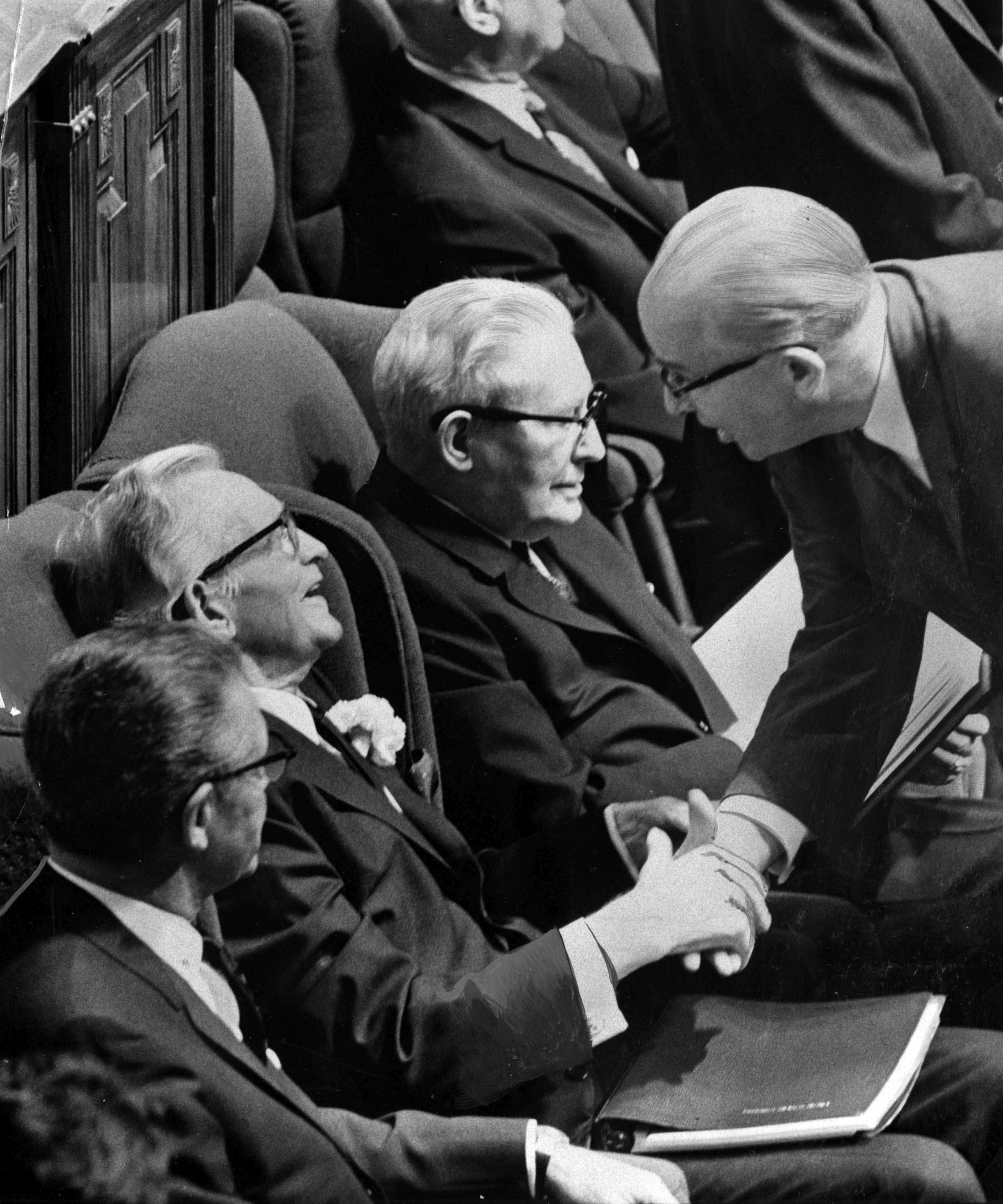 President David O. McKay, second from left, in general conference with his counselors, being greeted by Ezra Taft Benson of the Quorum of the Twelve (standing). From 1963 to 1970, both counselors to President McKay, N. Eldon Tanner, second counselor, left, and Hugh B. Brown, first counselor, right, were from Canada. President Tanner ultimately served in the First Presidency for more than nineteen years as counselor to four Church Presidents. (Deseret News)
President David O. McKay, second from left, in general conference with his counselors, being greeted by Ezra Taft Benson of the Quorum of the Twelve (standing). From 1963 to 1970, both counselors to President McKay, N. Eldon Tanner, second counselor, left, and Hugh B. Brown, first counselor, right, were from Canada. President Tanner ultimately served in the First Presidency for more than nineteen years as counselor to four Church Presidents. (Deseret News)
Hugh B. Brown also served in the First Presidency of the Church. Born in Salt Lake City, he moved to Canada in his teens with his family in 1899, and in the years that followed he had an interesting and varied career with many ups and downs. He worked in agriculture, ranching, real estate, and grain marketing, became an officer in the Canadian military, recruited and trained troops from southern Alberta to serve in the First World War, studied and practiced law in both Canada and the United States, ran unsuccessfully for a seat in the US Senate, held significant offices in the public service, and taught at Brigham Young University. Interspersed with the various career paths, he served in many Church callings, including president of the Lethbridge Stake, 1921–27; president of the Granite Stake in Salt Lake City, 1929–35; president of the British Mission, 1937–40; coordinator of LDS servicemen, 1941–44; and again president of the British Mission, 1944–46. Throughout his life, he was well known as an interesting and inspiring teacher and extraordinary public speaker. While working as an attorney and executive for an oil company in Edmonton, 1950–53, he became a popular teacher at the institute and in Sunday School.[90]
In 1953, at the age of sixty-nine, he was chosen to be a General Authority of the Church, serving as an Assistant to the Twelve until 1958, when he became one of the Twelve Apostles. In 1961, he was called to be a counselor to David O. McKay, President of the Church, and served in that capacity until 1970. A man of intelligence, wisdom, leadership, and spiritual power, he inspired generations of Latter-day Saints.[91]
Ardeth Greene Kapp was raised in Glenwood, Alberta, thirty-five kilometres north and west of Cardston. From her faithful Latter-day Saint parents, extended family, and neighbours in this small Canadian town, she learned important life lessons and strengthened her faith. She married Heber Kapp in 1950, and the young couple settled in Utah.[92] In the years that followed, Ardeth Kapp earned her master’s degree in education, specializing in curriculum development and leadership; created a series of children’s educational television programs; and spent twelve years on the faculty of Brigham Young University.[93] In 1977, she published her first book, and in the following years she produced sixteen more volumes of inspirational writings.[94] In 1984, while her husband, Heber, was serving as a stake president, Kapp was called to be Young Women General President, an office she held for eight years.[95]
Ardeth Kapp’s tenure as General President left a lasting mark on generations of Young Women in the Church. In a worldwide satellite broadcast in November 1985, she and her counselors introduced the new Young Women focus, values, theme, logo, and Personal Progress program. Ardeth’s address electrified her audience as she spoke of seeing “the crest of a great wave” of righteous, committed young women whose influence and strength would move forward the Lord’s work in the latter days, challenging them to “awake, arise, and go forth” to unitedly take their place as leaders in their own nations. She invited each to live the Young Women values—faith, divine nature, individual worth, knowledge, choice and accountability, good works, and integrity—and, with growing faith and testimony, to “stand for truth and righteousness.”[96] After Ardeth served for eight years as Young Women General President, she and Heber returned to Canada to preside over the Canada Vancouver Mission from 1992 to 1995. In 2000, they again returned to Canada as president and matron of the Cardston Alberta Temple, where they had been married fifty years earlier.[97]
 Many General Authorities and general Church officers attended the rededication of the Cardston Temple in June 1991. Among them were three who had been born and raised in southern Alberta. On the left is Ardeth G. Kapp, who was in 1991 the Young Women general president. Victor L. Brown, centre, had served from 1972 to 1985 as Presiding Bishop of the Church, after which he served in the First Quorum of the Seventy before being named an emeritus General Authority in 1989. On the right is Elaine Jack, who was then serving as general president of the Relief Society. (Mike Cannon, Church News)
Many General Authorities and general Church officers attended the rededication of the Cardston Temple in June 1991. Among them were three who had been born and raised in southern Alberta. On the left is Ardeth G. Kapp, who was in 1991 the Young Women general president. Victor L. Brown, centre, had served from 1972 to 1985 as Presiding Bishop of the Church, after which he served in the First Quorum of the Seventy before being named an emeritus General Authority in 1989. On the right is Elaine Jack, who was then serving as general president of the Relief Society. (Mike Cannon, Church News)
Born and raised in Cardston, Alberta, Elaine Low Jack has spent a lifetime in service to the Church and community. As a teenager, she assisted her grandfather, the stake patriarch, by transcribing patriarchal blessings in a quiet room adjacent to the foyer of the Cardston Alberta Temple. After graduating as valedictorian of her class at Cardston High School, Jack attended the University of Utah. She married Joseph E. Jack in the Cardston Temple in 1948 and accompanied him to New York City, where Joseph had a medical internship. Wherever they lived, as the young couple moved with the various stages of Joseph’s medical career, Elaine served faithfully in the Church and the community. In Salt Lake City, she was a stake Relief Society president and for eleven years was a member of the Relief Society general board. She also served as president of the Salt Lake County Medical Auxiliary, a representative on both the Women’s Legislative Council and the Salt Lake Council of Women, and as a lecturer for the American Cancer Society.[98] In 1987, she was called as a counselor in the Young Women General Presidency, serving for three years before being called as Relief Society general president in 1990.[99]
During her seven-year term as Relief Society General President, from 1990 to 1997, Elaine Jack was sensitive to the vast differences in culture and economic circumstances of Relief Society women living in various parts of the world. She focused on unifying principles, such as strengthening families, building testimonies, exercising charity, and blessing individual women. She listened to the concerns and experiences of women from diverse backgrounds and cultures and tried to make Relief Society relevant to their lives. During her presidency, the Relief Society celebrated its sesquicentennial through local service projects, the writing of local Relief Society histories, a worldwide broadcast, and an introduction of a literacy program to bless the lives of women throughout the world.[100] In 1997, after being released as Relief Society General President, Elaine returned to Canada with her husband, Joseph, as president and matron of the Cardston Alberta Temple, where they served for three years.[101]
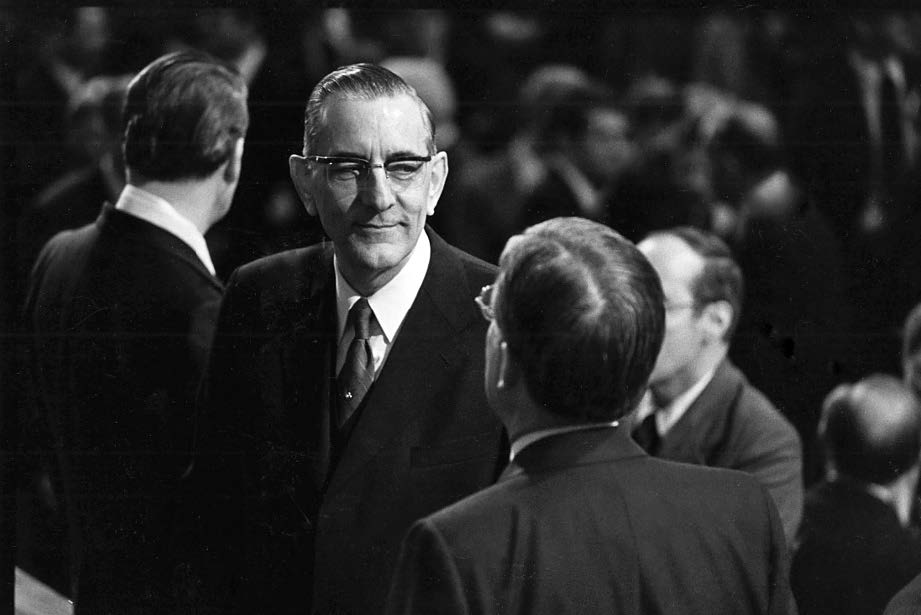 Jacob de Jager converted to the Church in 1960 in Toronto, went on to become a member of the First Quorum of Seventy in 1976. (IRI)
Jacob de Jager converted to the Church in 1960 in Toronto, went on to become a member of the First Quorum of Seventy in 1976. (IRI)
Jacob de Jager was born in The Hague, Netherlands, in 1923. He studied languages and became fluent in English, Spanish, French, and Malaysian, in addition to his first language, Dutch. During World War II, he was an interpreter for the Canadian Army. In 1960, he was a successful business executive for an international electronics company, working in Toronto, when he and his family became converts to the Church during the administration of the Canadian Mission president, Thomas S. Monson. In the following years, de Jager filled numerous Church leadership positions throughout the world, as his employment took him from place to place. In 1976, he was called to the First Quorum of the Seventy and served for seventeen years.[102]
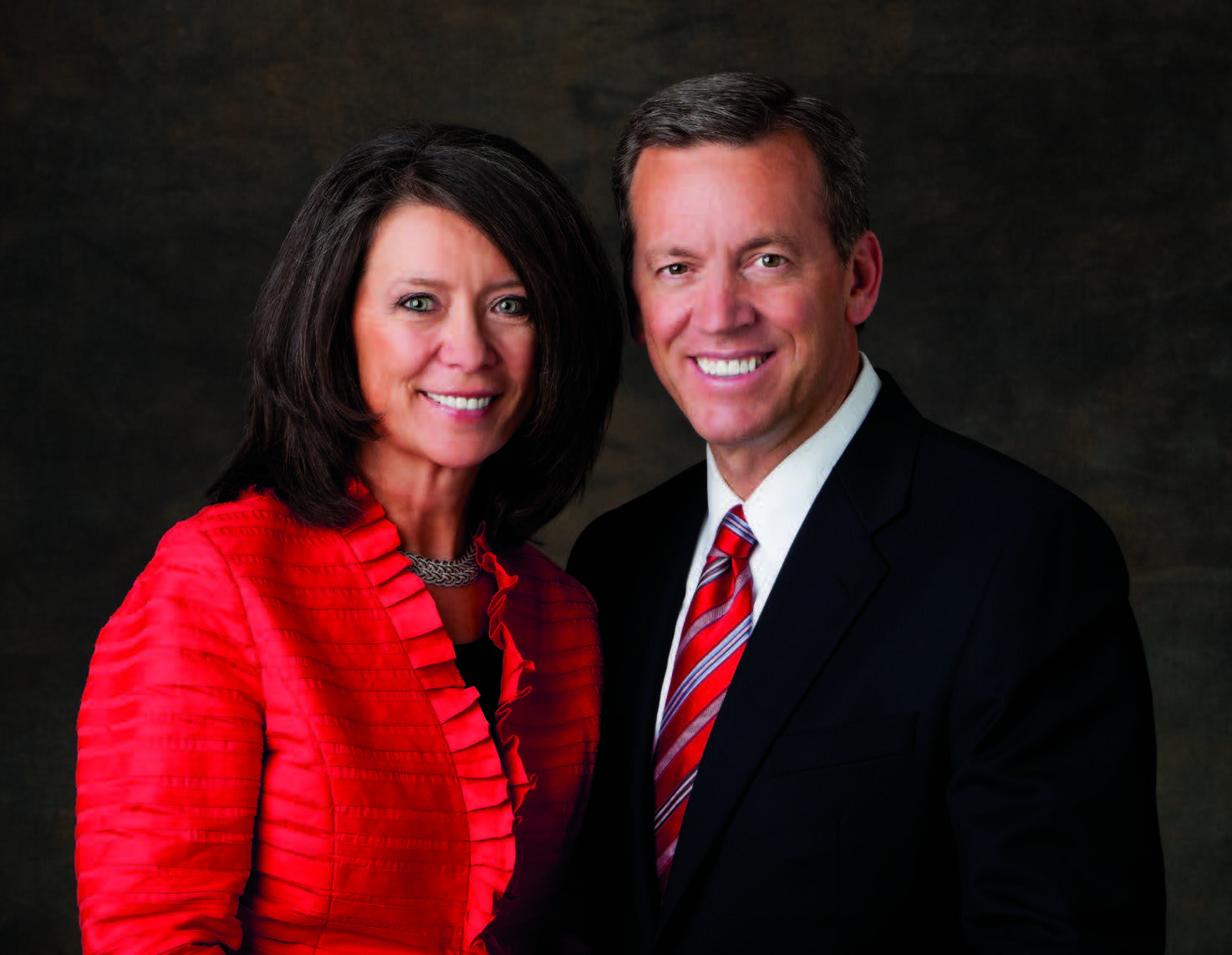 Born in Magrath, Alberta, Randall K. Bennett, shown here with his wife, Shelley, was a mission president prior to being called to the Second Quorum of Seventy in 2011. (IRI)
Born in Magrath, Alberta, Randall K. Bennett, shown here with his wife, Shelley, was a mission president prior to being called to the Second Quorum of Seventy in 2011. (IRI)
Alexander B. Morrison joined the Church in Edmonton in the early 1950s while a student at the University of Alberta. He later obtained a PhD at Cornell University. A scientist of international stature, he chaired several committees of the World Health Organization dealing with tropical diseases and other issues related to public health in Africa and other developing areas of the world. He was a highly respected civil servant in Ottawa, serving as Assistant Deputy Minister in charge of environmental, drug, and food safety issues for the Department of National Health and Welfare. When he was called as a General Authority in 1987, he was chair of the Food Sciences Department at the University of Guelph in Ontario. He served in the Seventy for thirteen years.[103] As an emeritus General Authority after 2000, Morrison was instrumental in the success of a vast Inner City Project in Salt Lake City, which mobilized missionaries and other volunteers, including professionals, to meet the needs of underprivileged people in the central part of the city.[104] He received distinguished awards for his humanitarian service, including the David M. Kennedy Service Award.[105] He also authored seven LDS books.[106] His pioneering book Valley of Sorrow: A Layman’s Guide to Understanding Mental Illness was particularly valuable for Latter-day Saints in helping them understand mental illness in a gospel context.[107]
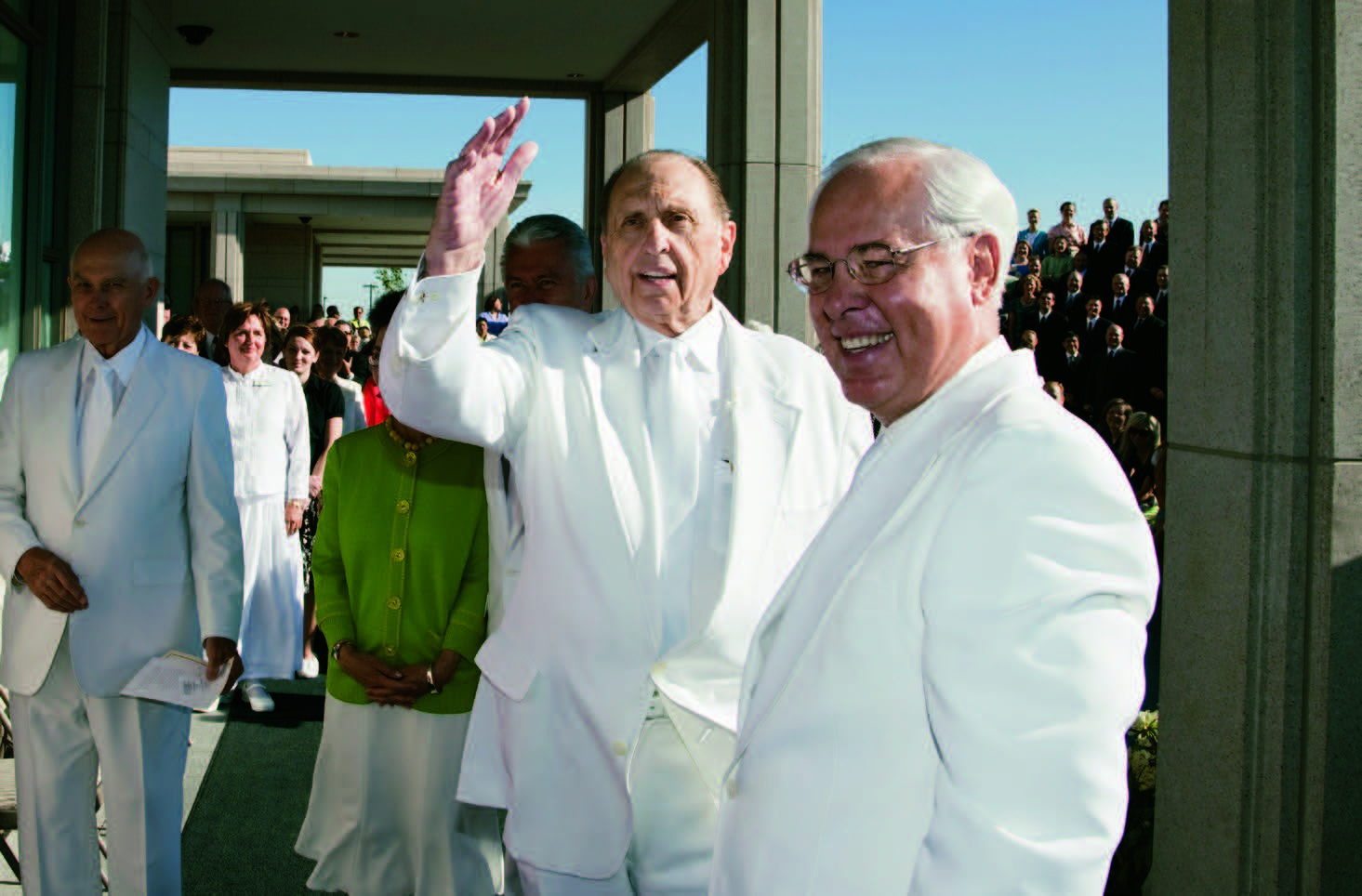 President Thomas S. Monson, centre, with raised hand, and William R. Walker, right, Executive Director of the Temple Department, at the dedication of the Oquirrh Mountain Temple in 2009. Raised in Raymond, Alberta, Walker served as a bishop, stake president, and mission president before becoming a Seventy in 2002. (IRI)
President Thomas S. Monson, centre, with raised hand, and William R. Walker, right, Executive Director of the Temple Department, at the dedication of the Oquirrh Mountain Temple in 2009. Raised in Raymond, Alberta, Walker served as a bishop, stake president, and mission president before becoming a Seventy in 2002. (IRI)
Victor L. Brown, born in Cardston, Alberta, in 1914, became Presiding Bishop of the Church in 1972 and served in that responsibility for thirteen years. Called in the late 1990s, Canadian-born Sharon Greene Larson served five years in the Young Women General Presidency.[108]
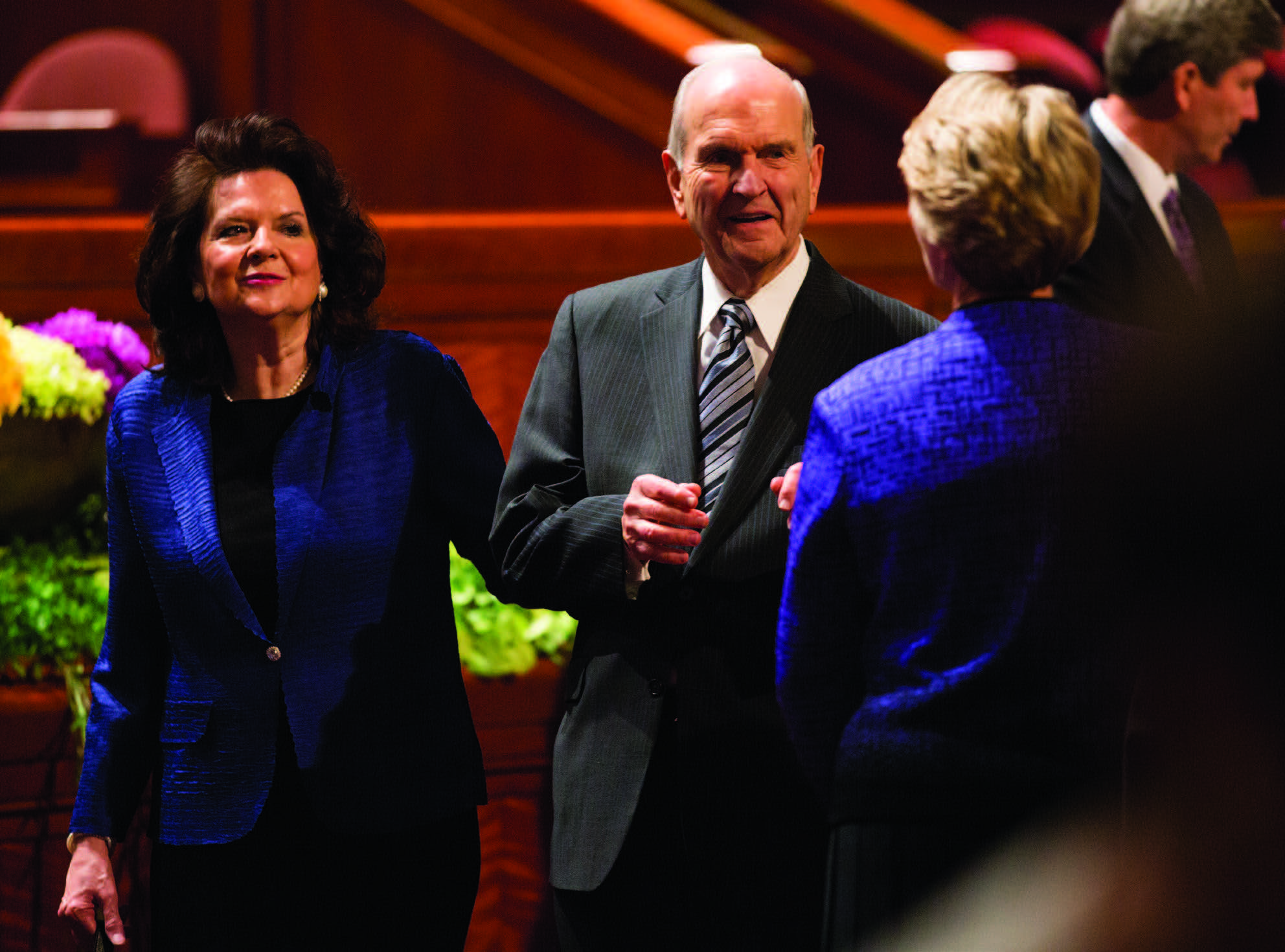 Left to right: Wendy Watson Nelson, Russell M. Nelson. Born in Raymond, Wendy Watson obtained a PhD in family therapy and gerontology and had a successful career as a professor and author. She married Russell M. Nelson of the Quorum of the Twelve in 2006. (IRI)
Left to right: Wendy Watson Nelson, Russell M. Nelson. Born in Raymond, Wendy Watson obtained a PhD in family therapy and gerontology and had a successful career as a professor and author. She married Russell M. Nelson of the Quorum of the Twelve in 2006. (IRI)
Several other Canadians became General Authorities of the Church in the twentieth and twenty-first centuries and served as Seventies in the First and Second Quorums of the Seventy, including Ted E. Brewerton, Merlin R. Lybbert, William H. Bennett, Robert Sackley, Gerald E. Melchin, Randall K. Bennett, Lowell O. Wood, and William R. Walker. At least two dozen Canadians have served as regional representatives of the Twelve and as Area Seventies,[109] and over forty have served as temple presidents (see names in timelines), accompanied by their wives. In addition, more than sixty-five Canadians, with their wives as companions, have been called as presidents of LDS missions throughout the world (see table on pages 18–19). Canadian mission presidents and their wives have served on every continent and have made a significant contribution in spreading the gospel not only in Canada and the United States but in many lands across the earth.
Canadians in South Africa
Canadians were particularly important in continuing the missionary work in South Africa in the 1950s. The South African government had long placed quotas on the number of LDS missionaries that could enter the country, but in 1955 the government completely discontinued issuing visas for foreign missionaries, regardless of their denomination. Because Canadians were from a Commonwealth country, they were not subject to the visa restrictions. Thus, between 1955 and 1958, when the restrictions were lifted, large numbers of Canadian missionaries, ninety-seven altogether, served in South Africa. In fact, for two years, from July 1955 until June 1957, all of the missionaries arriving in the South Africa Mission were from Canada. Even the mission president from 1957 to 1960, Glen G. Fisher, was a Canadian.[110]
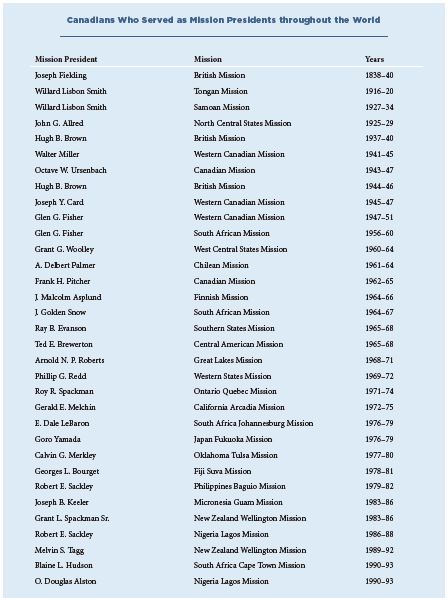
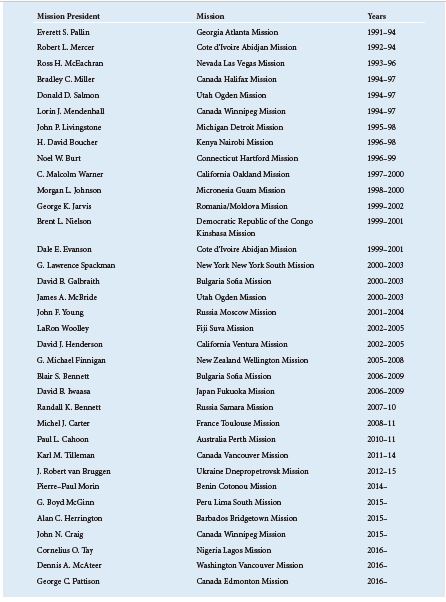
Contributions to Canada
Although Latter-day Saints composed less than 1 percent of the total Canadian population in 2015 and only 2 percent of the population in Alberta, the Church has been recognized as a major force for good among the general populace. Canadian Mormons have made significant contributions to Canada in numerous ways, in government and military service, in business and the professions, in athletics and the arts, to name only a few.
Government and Military Service
Canadian Latter-day Saints have long been active participants in municipal, provincial, and federal politics, especially in Alberta. In 1902, John W. Woolf became the first Latter-day Saint to be elected as Cardston’s representative in the Assembly of the Northwest Territories. When Alberta became a province in 1905, Woolf was elected to the Alberta Legislative Assembly and served until 1912, followed by his brother Martin Woolf, who served from 1912 to 1921. George Stringham was elected in 1921 and served until 1935. After the Social Credit Party swept to power in Alberta in 1935, two southern Alberta Mormons, N. Eldon Tanner and Solon Low, gained prominence as high-ranking Cabinet Ministers in the new Social Credit government. Numerous other Latter-day Saints have also been elected to the provincial legislature in Alberta over the years.[112] John Blackmore was the first Latter-day Saint to be elected to the Canadian Parliament. He served in Ottawa from 1935 to 1958 as the Member of Parliament from Lethbridge. Other LDS Members of Parliament included Solon Low, who served for fourteen years, 1944–58, as the national leader of the Social Credit Party, and more recently Jim Hillyer and Grant Hill. Three Mormons have been elected mayors of major Alberta cities—David H. Elton in Lethbridge, 1935–43; Don H. MacKay in Calgary, 1950–59; and Cecil Purves in Edmonton, 1977–83. Many other Latter-day Saints have served on town and city councils and committees.[113]
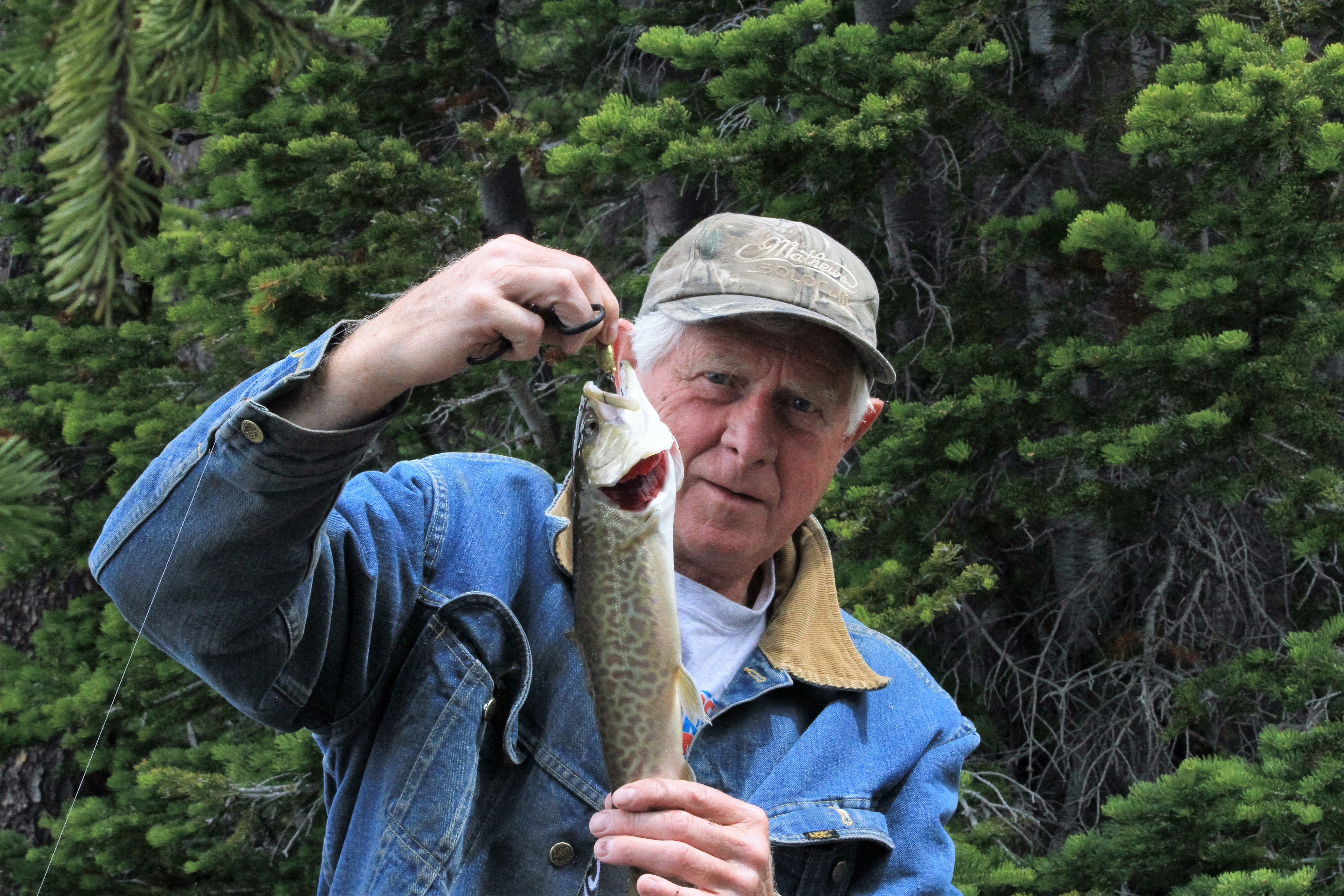 For more than ten years, from 1994 to 2004, Grant Hill, a Church member from Okotoks, Alberta, was a Member of Parliament. A physician by profession, Hill represented the federal riding of Macleod. (Grant Hill)
For more than ten years, from 1994 to 2004, Grant Hill, a Church member from Okotoks, Alberta, was a Member of Parliament. A physician by profession, Hill represented the federal riding of Macleod. (Grant Hill)
Large numbers of Latter-day Saints enlisted for service in the First and Second World Wars. This was particularly notable in southern Alberta, where groups of LDS men joined the military together. It has been said that the high enlistment rate among Latter-day Saints reflected the desire for Church members to demonstrate their loyalty to Canada.[114] Hugh B. Brown became an officer and was heavily involved in recruiting and training troops from southern Alberta. A number of Canadian Mormons gave their lives in wartime service.[115]
Business and the Professions
Canadian Latter-day Saints have also excelled in business, academics, and the professions. Reflecting strong educational values, large numbers of Mormons have served in the professions. With a religion that teaches the value of hard work and excellence, several have risen to the top tiers of their chosen careers.
Business executive Jack Armstrong married a Latter-day Saint woman, June Keith, and was later baptized in 1952. He became chief executive officer of Imperial Oil Canada and held that position between 1973 and 1981. He also served in other capacities, including director of the Royal Bank of Canada, director of the International Chamber of Commerce, and officer of the Order of Canada. It was written of him that he “enjoyed, throughout his career, a personal reputation for moral and ethical standards unsurpassed in Canadian business.”[116]
An example of many Canadian Church members who have excelled in scholarship and the professions, John Borrows, a First Nations Latter-day Saint from Ontario, became a distinguished law professor. He served on the faculty of several prestigious universities in Canada and the United States, received Canada's highest academic honour through induction as a member of the Royal Society of Canada, and in 2015 he was the Canada Research Chair in Indigenous Law at the University of Victoria Law School. He specializes in laws and treaties involving First Nations people and has published several books on the subject.[117]
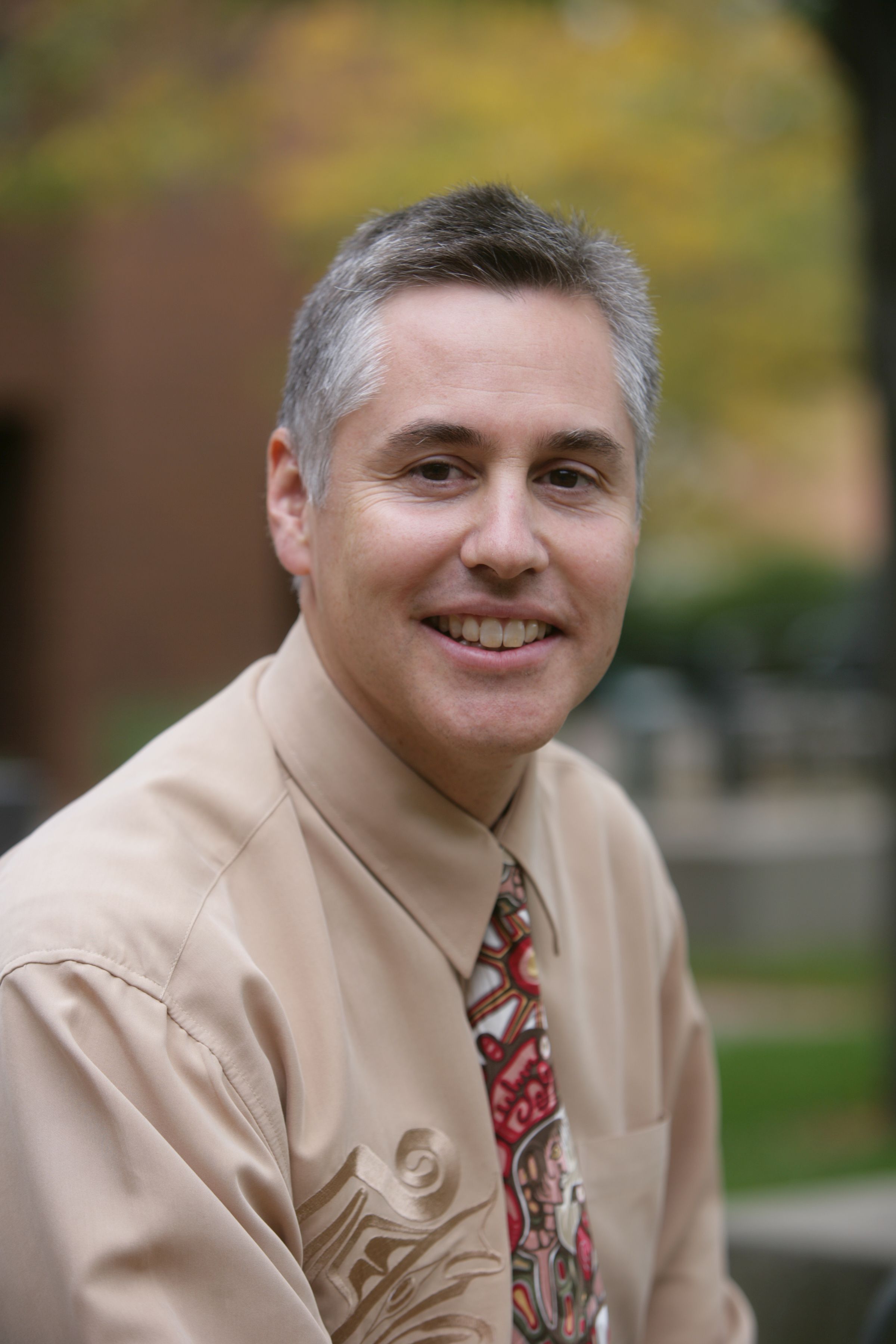 John Borrows, a respected law professor and author, became a leading authority on legal aspects of First Nations treaties. (John Borrows)
John Borrows, a respected law professor and author, became a leading authority on legal aspects of First Nations treaties. (John Borrows)
David B. Galbraith, born in Lethbridge, obtained his PhD in international relations from Hebrew University of Jerusalem, specializing in conflict resolution and Arab-Israeli relations. He served for fifteen years as director of the BYU Jerusalem Center. Although Galbraith lived more than twenty years in Israel and spent additional years in Utah as a BYU professor, he also served as president of the Ottawa Branch from 1967 to 1968 and as president of the Montreal Quebec Temple from 2009 to 2012.[118]
Many other Latter-day Saint Canadians also distinguished themselves in the professions. Robert B. White, an Edmonton attorney, was listed among the best lawyers in Canada. White has authored four books on advocacy, two of which were all-time best sellers, and has appeared before numerous judicial bodies, including the Court of Queen’s Bench of Alberta and the Supreme Court of Canada.[119] He also served as a stake president and an Area Seventy.[120]
Tofy Mussivand became one of the world’s most respected scientists and inventors, a pioneer in creating medical devices, including the artificial cardiac pump. In 2015, he was chair and director of the Cardiovascular Devices Program at the University of Ottawa Heart Institute. He held at least twenty patents, had published more than five hundred books and papers and received many national and international honours and awards. He was named a fellow of the Royal Society of Canada in 2000 and was awarded the Queen Elizabeth II Diamond Jubilee Medal in 2013.[121] Mussifand’s achievements have helped make Canada one of the world leaders in medical devices and artificial hearts.[122]
Medical doctor and researcher Daren K. Heyland is noted for his development of a new formula for tube-feeding which reduces infection, and is one of the world’s leading experts on critical care and end-of-life planning. By 2016, Heyland, a professor of medicine at Queen’s University in Kingston, Ontario, had published 280 peer-reviewed articles, given over Three hundred international presentations, and received more than ninety-one million dollars in external grants to fund his research projects. He has been the recipient of numerous prestigious honours and awards.[123]
Athletics
It is not surprising that a number of outstanding athletes have emerged from Latter-day Saint communities in southern Alberta and elsewhere, considering that Mormons adhere to a health code called the Word of Wisdom (which prohibits the use of tobacco and alcohol), that Church teachings encourage individuals to develop talents and abilities, and that Church programs for many years have included organized sporting activities. Some southern Alberta towns have a strong culture of basketball, football, and softball, with activities and clinics that prepare children with skills and experience to be successful players on their competitive high school teams. Graduates of this focused training have gone on to be stars on university and Olympic teams. Phil Tollestrup played on the Canadian national basketball team and was one of the top scorers in the 1976 Olympics. Tim Tollestrup likewise played for Canada in the 1996 Olympics, as did Shawna Molcak. Jimmy Balderson and Tom Karren were top basketball players for Brigham Young University, and Danny Balderson’s number was retired for his outstanding play at the University of Lethbridge.[124] Karl Tilleman, born in Utah but raised in Calgary, became an outstanding athlete at the University of Calgary in the early 1980s. He went on to play on the Canadian national basketball team at the 1983 Commonwealth Games and in the 1984 and 1988 Olympics.[125]
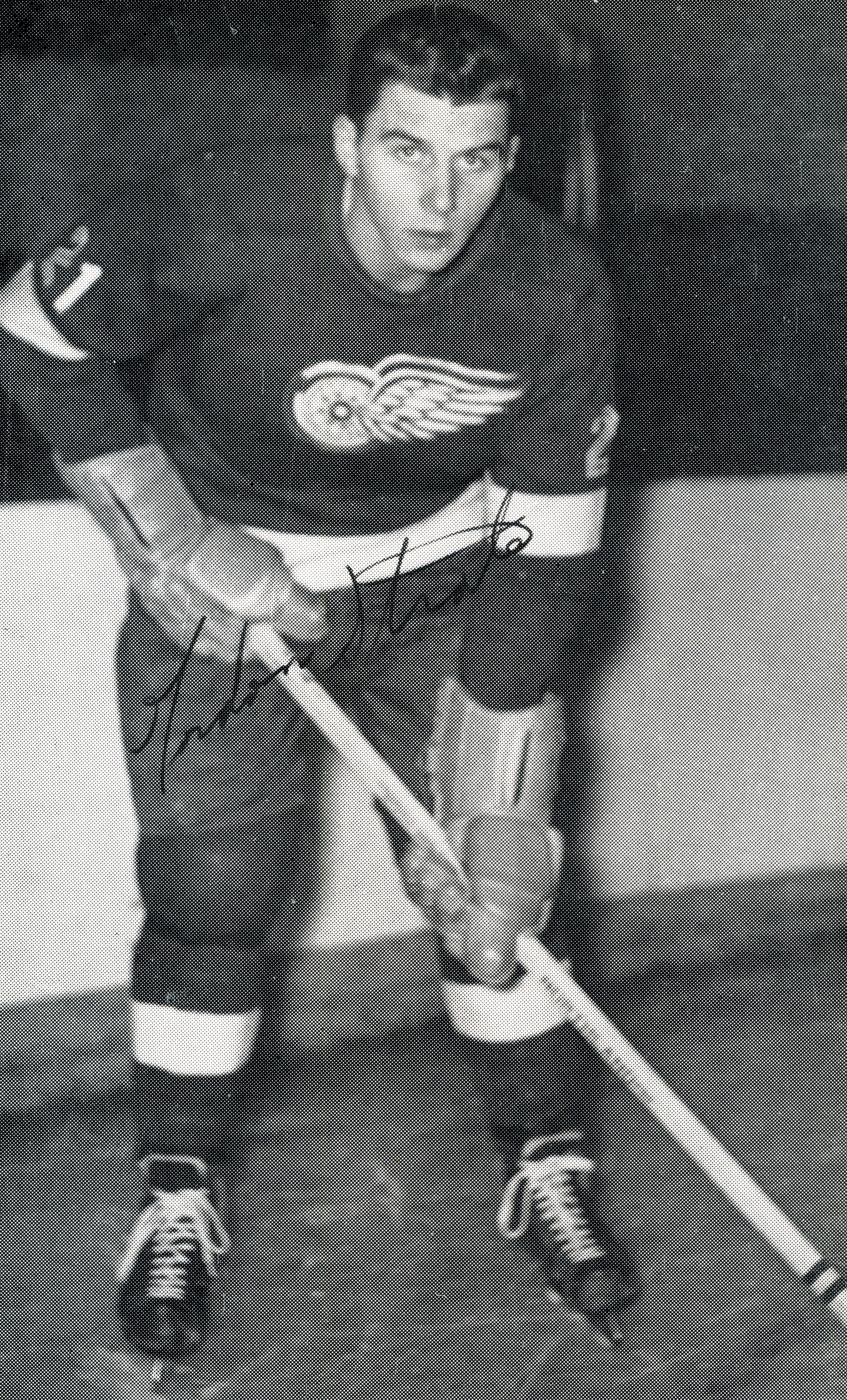 Gordon Strate, a faithful Latter-day Saint from Edmonton, Alberta, played parts of three seasons, from 1956 to 1959, with the Detroit Red Wings of the National Hockey League.[126] (Ronald David Bissett)
Gordon Strate, a faithful Latter-day Saint from Edmonton, Alberta, played parts of three seasons, from 1956 to 1959, with the Detroit Red Wings of the National Hockey League.[126] (Ronald David Bissett)
Ben Cahoon distinguished himself during his thirteen-year career with the Montreal Alouettes of the Canadian Football League, 1998–2010, helping his team win three Grey Cup championships and setting the all-time CFL record for pass receptions. He was named the Grey Cup Most Outstanding Canadian in 2003 and 2009 and was chosen as the Most Outstanding Canadian in the CFL in 2002 and 2003. Cahoon was inducted into the Canadian Football League Hall of Fame in 2014, and his jersey number, 86, was retired by the Alouettes in 2016. Football stars, including Lloyd Fairbanks and the Ralph brothers, Brock and Brett, from Raymond, have also risen to play professionally in the CFL.[127]
Raymond Knight organized the first rodeo in Canada, called the Raymond Stampede, in 1902 and personally won the steer-roping contest. He competed in many rodeo events during the following years, won the North American Calf Roping championships in 1917, 1918, and 1919, and won other coveted recognitions. He has been called the “Father of Canadian Professional Rodeo.”[128]
Design and the Arts
Some notable Latter-day Saints distinguished themselves in the arts. Mary Lambert, born in Ontario, became a popular children’s entertainer. Beginning her career in 1993, she has presented concerts all over Canada, and as of 2016 she had produced eleven CDs and had received two Juno nominations for her work.[129] Simon Dewey, a British-born artist who lives in Alberta, has become a respected painter. He is known for his portrayals of the Saviour, which communicate great tenderness and compassion.[130] Richard Comely is widely known as a cartoonist and illustrator. In 1975, he created the Captain Canuck comic book series, and he has also been successful writing and illustrating children’s books.[131] Other examples include Tom Roulstone, who immigrated to Canada from Ireland as a child and became a successful novelist, author of seven LDS historical fiction books; and Alberta-born Darrel Nelson, who also became a popular fiction author.
Community Service
Latter-day Saints working collectively have made significant contributions to their communities in areas such as Scouting, researching family history, and helping those in need. Strong LDS family values, healthful living habits, and a strong educational and work ethic have made Mormons solid contributors to the well-being of their communities. In recent years, Mormons have worked together with other groups and religions to promote and maintain strong moral and ethical values.
Scouting
Louisa Grant Alston made a significant contribution to her community and to Canada through her early involvement in Scouting. The Scouting movement began in England in 1908 and soon spread to North America. When the first Scout troop was formed in Magrath, Alberta, in the spring of 1914, she volunteered to help, and by June 1914, she had become the first female Scoutmaster in Canada. Through her energetic and creative leadership, her Magrath troop learned not only to camp and appreciate nature but to be obedient, responsible, and excellent citizens. During World War I, Alston’s Scouts rendered much service in the community, doing errands for the Red Cross and generally assisting others with tasks that needed to be done. When the Governor-General of Canada, the Duke of Devonshire, visited Lethbridge in 1917, Louisa was selected to take a large group of Scouts from the surrounding communities to meet him. The distinguished visitor was very impressed with Alston and her sixty Scouts. Shortly after the visit, Alston was appointed a Scout commissioner, the first woman to attain that rank. As Scout commissioner, Alston visited many towns and attended international jamborees, where she promoted the Scouting movement and encouraged boys to live according to the values of Scouting. In 1939, she was presented with the Medal of Merit by Boy Scouts of Canada for her “particularly fine service” as “one of the pioneers of Scouting in Canada.”[134]
Alston was also a leader in promoting culture in her community. Although living in pioneer conditions during the early settlement period in southern Alberta, she organized the first marching band in Magrath and did much to encourage young people to develop musical talents. She taught music lessons, was instrumental in bringing the first organ to Magrath, and promoted community theatre. She continued to be involved in her community until her death in 1945. In 2011, the Alberta Legislative Assembly honoured her memory by designating a park in her name.[135]
The Church of Jesus Christ of Latter-day Saints has long been a strong supporter of Scouting. The first known LDS Scout troop in Canada was organized in Aetna, Alberta, in 1911. N. Eldon Tanner was a member of that first troop.[136] From the earliest days of Scouting in Canada, Scout troops were organized in Latter-day Saint communities in southern Alberta. In the years that followed, Scouts were organized in LDS congregations across the country, directed by dedicated and knowledgeable leaders, contributing to strength of boys and communities. Some Church members also provide much leadership beyond the troop level, volunteering at the area, council, and national levels. To illustrate the disproportionately large role that Latter-day Saints have had in Canadian Scouting, it was noted that in 2011, there were seventy thousand youth enrolled in Scouts Canada and that seven thousand of those, a full 10 percent, were in troops sponsored by the LDS Church. This is particularly impressive when it is noted that the LDS population of Canada is only .53 percent of the total.[137]
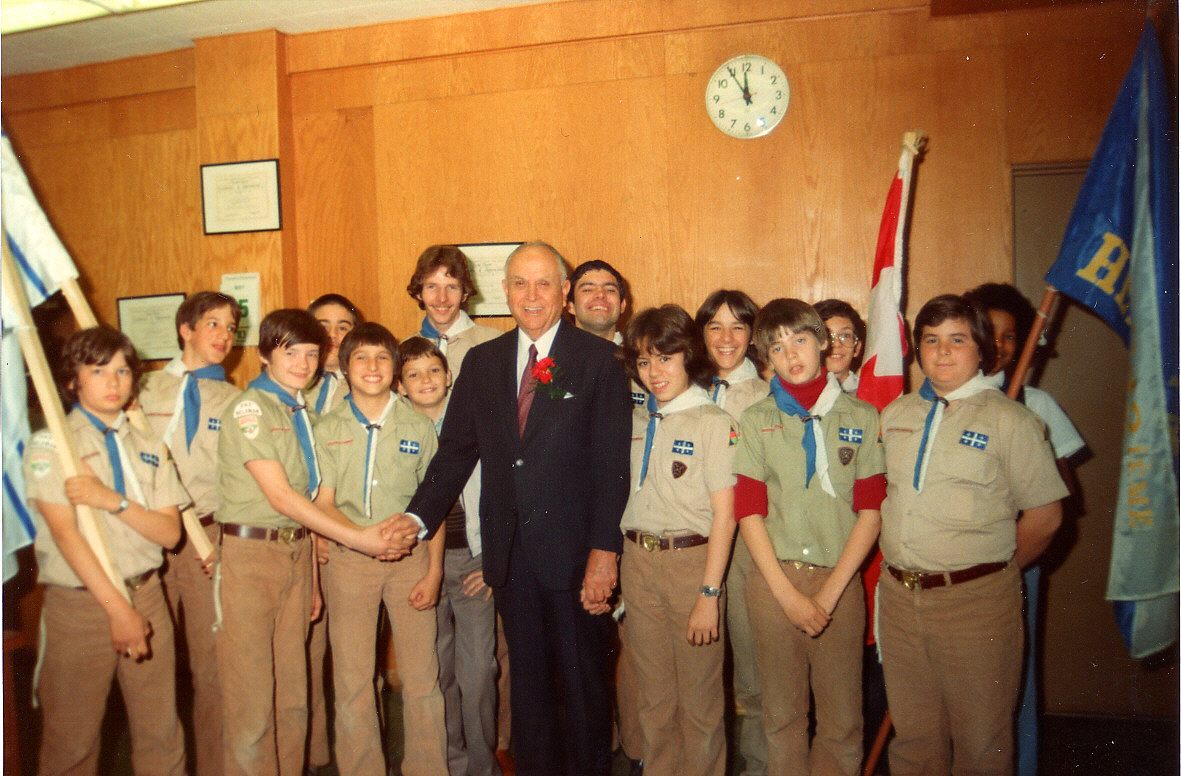 Scouting was well established in the Church in Quebec when David B. Haight of the Quorum of the Twelve met with a large group of uniformed Scouts in Montreal about 1980. Elder Haight was visiting the conference of the Montreal Quebec Stake. (Nicolas Athanassi)
Scouting was well established in the Church in Quebec when David B. Haight of the Quorum of the Twelve met with a large group of uniformed Scouts in Montreal about 1980. Elder Haight was visiting the conference of the Montreal Quebec Stake. (Nicolas Athanassi)
Family History Centres
All across Canada, from Victoria, British Columbia, to St. John’s, Newfoundland, from Whitehorse, Yukon, to Windsor, Ontario, family history centres have been significant assets to their communities. More than 180 family history centres had been established in Canada by early 2017. With genealogy becoming one of the most popular hobbies in the world, LDS family history centres are welcomed into localities, where they continue to be popular attractions. Family history conferences, such as the popular “One World—One Family” conference held annually in the greater Toronto area, in which Latter-day Saints partner with local genealogical societies to invite guest speakers and organize workshops, have been an effective means of reaching out to the general public.[138]
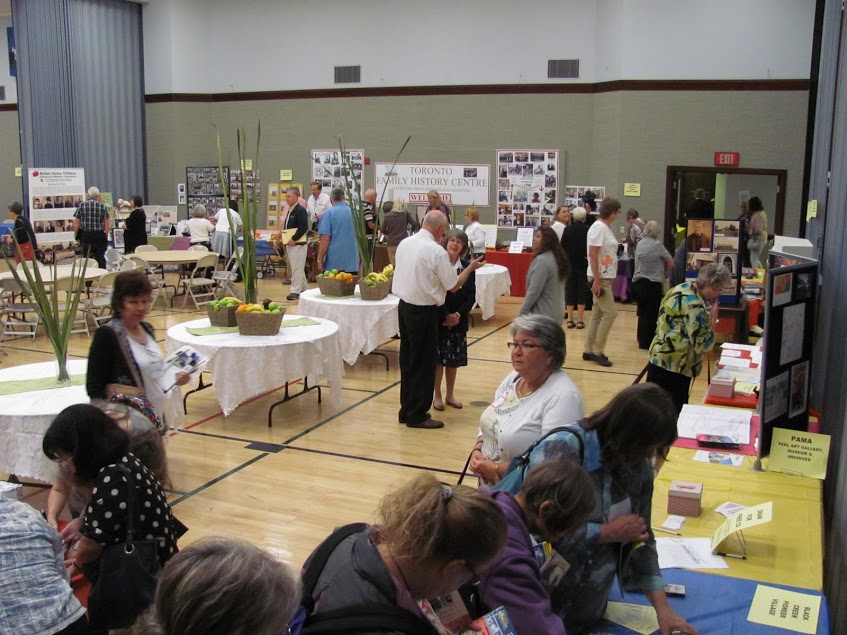 Family history conferences have been organized by Latter-day Saints in various places across Canada, drawing in hundreds of family history enthusiasts, both LDS and non-LDS. This photograph shows displays at the popular “One World—One Family” conference held in Brampton, Ontario, in August 2015. (Lee Hewitt)
Family history conferences have been organized by Latter-day Saints in various places across Canada, drawing in hundreds of family history enthusiasts, both LDS and non-LDS. This photograph shows displays at the popular “One World—One Family” conference held in Brampton, Ontario, in August 2015. (Lee Hewitt)
Helping Those in Need
During the Great Depression, almost a decade of severe drought brought terrible suffering to people living across the plains and prairies of Canada and the United States. Saskatchewan was particularly hard hit. In 1934 the Lethbridge Stake organized a relief effort for the neighbouring province. Southern Alberta farmers, whose crops were not so devastated by drought because of irrigation and improved farming practices, donated a boxcar full of farm produce. Non-Church members in the area, wanting to participate in the effort, donated an additional boxcar of food. The railroad, in the spirit of cooperation, transported the shipment free of charge. The United Church of Canada organized the distribution of food in Saskatchewan.[139]
After the Second World War, many Church members in Europe were starving. Ezra Taft Benson of the Quorum of the Twelve travelled throughout the war-torn countries to arrange for emergency assistance. Upon his return, Church members in Alberta were asked to send wheat to the suffering German Saints. The wheat was donated by Latter-day Saint farmers in southern Alberta. Ellison Milling in Lethbridge packaged the wheat and shipped it to Europe for distribution. The bags, equipment, and labour were donated. The first shipment, ninety thousand pounds, was sent 22 January 1948. Alma Sonne, president of the European Mission, wrote that the Canadian wheat had “prevent[ed] many of the members from starving.”[140]
Because of the severe famine in Ethiopia, the First Presidency called for a special fast on 27 January 1985 on behalf of the starving Ethiopian people. Church members in the United States and Canada were invited to fast, pray, and donate generously.[141] Canadian Latter-day Saints responded willingly. Donations across Canada that day totalled $250,000. But, because of Canadian laws, only a small percentage of this money could be sent directly to Church headquarters in Salt Lake City. To resolve the problem, the Church in Canada donated the entire amount to the Canadian Red Cross, which was providing aid to Ethiopia. As an added bonus, the Alberta government matched the donation, making the total $500,000. A further magnification of the donation came when the Canadian government matched the $500,000 with another $500,000. Thus, the Canadian Red Cross received a $1,000,000 donation to provide relief for the suffering Ethiopians, the largest single donation they had received to that date.[142]
Canadian Mormons have consistently been willing to help those in need. In the 2013 disastrous flooding in Alberta, Church members mobilized to assist with cleanup. Volunteers, some travelling a great distance, came to High River week after week to help residents remove debris, damaged drywall, flooring, and furniture, clear out thick deposits of foul-smelling sludge from their flooded basements and clean up other flood damage. Their yellow Mormon Helping Hands vests quickly became coated with mud, but their presence lifted the hearts of many whose lives had been devastated by the flooding.[143] Latter-day Saint Canadians likewise provided much help to those affected by flooding in other areas, including Richelieu, Quebec, Calgary, and along the Red River in Manitoba and North Dakota.
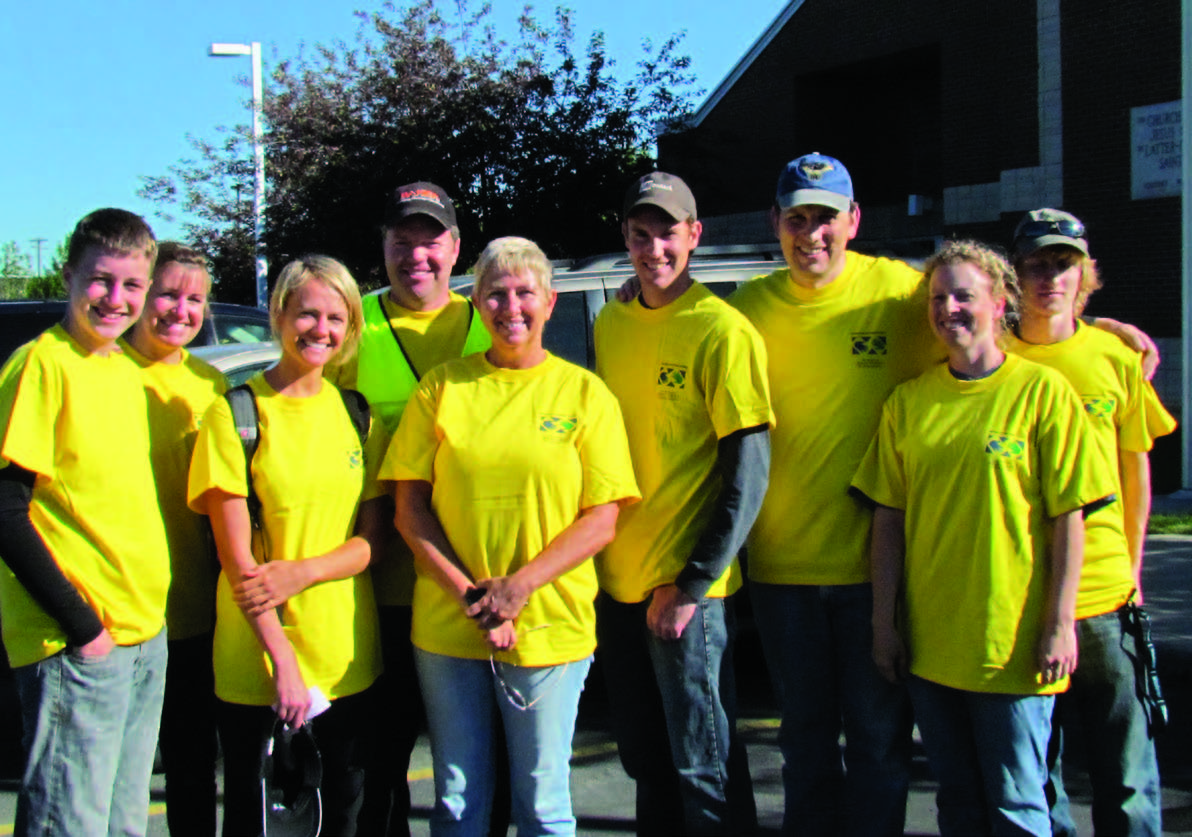 Willing workers, dressed in yellow Mormon Helping Hands T-shirts, have been a welcome sight to disaster victims across Canada. This group of young single adults and leaders are shown in High River, Alberta, helping with cleanup following a severe flood in 2013. (Linda Davis)
Willing workers, dressed in yellow Mormon Helping Hands T-shirts, have been a welcome sight to disaster victims across Canada. This group of young single adults and leaders are shown in High River, Alberta, helping with cleanup following a severe flood in 2013. (Linda Davis)
Food drives have become an important means for Latter-day Saint Canadians to reach out to their communities. The Church has become recognized for its ability to collect impressive, even record-breaking, quantities of nonperishable food for local foodbanks. Success is attributed to its effective publicity, superior organization, and large number of enthusiastic volunteers. Food drives have become annual events for LDS congregations across Canada, many partnering with other churches and service organizations. From the Thanksgiving Food Drives in British Columbia to the Winnipeg Harvest events in Manitoba, Latter-day Saints are engaged in helping the poor and needy and building bridges with other service-minded groups and individuals.[144] In Calgary, Church members in one ward held a food drive in 1977, and by 2005 the effort had grown to a citywide food drive involving all six stakes. The Calgary food drive set the Guinness World Record for the most food collected in a single day by gathering more than half a million pounds of food in 2008.[145] Other Church-organized service initiatives are also effective, such as the “Little Dresses for Africa” project, sponsored by the young women of the Sudbury Ontario Stake. The youth, with adult supervision, prepared and sewed over a hundred dresses for needy girls in Kenya.[146]
Everyday Living
Canadian Latter-day Saints, by being honest, hardworking, caring people with strong family focus and solid moral values, have contributed to a growing positive awareness of the Church among their fellow Canadians. As described in the previous chapter by Jarvis and Jarvis, Mormons are statistically better educated and enjoy a more stable family life than the general Canadian population. Furthermore, they have less unemployment, better health, and greater longevity than the average Canadian. These differences are attributed to LDS doctrines which emphasize the sacred nature of marriage and children, encourage education, and provide a code of health which excludes the use of alcohol and tobacco. Furthermore, LDS teachings on self-reliance encourage a solid work ethic. While Mormons have a strong focus on helping others in need, assistance is geared to help recipients, where possible, return to employment and independence.[147]
Supporting Family and Ethical Community Values
Mormons have been a strong influence for good, as they have made their voices heard on important moral, social, and ethical issues. Ken Kyle, for example, as head of the Canadian Cancer Society’s public policy advocacy division in Ottawa, was instrumental in banning smoking on commercial airlines, eliminating tobacco advertising, and having prominent warning labels printed on cigarette packages. Due in part to Kyle’s untiring efforts, the percentage of smokers among youth ages fifteen to nineteen fell from 44 percent in 1981 to 11 percent in 2012. He was awarded a Queen’s Jubilee Medal in 2003 for this accomplishment. His work has been a pattern for similar reforms throughout the world.[148]
Helen K. Warner, in 2007, led an effort to work with women in a provincial jail in Milton, Ontario, helping them stay in touch with their children. Among her initiatives was a program where volunteers recorded the incarcerated women reading to their children, after which a copy of the book and a CD of the recording were sent to the children. Helen also organized a program to assist women being released from custody at the Brampton court. Prior to this initiative, women were released wearing their prison clothing and with their few personal belongings in a garbage bag. Helen’s efforts helped women transition into their new life by giving them a backpack containing necessities, a phone card, and a coupon with which to buy clothing at the local Salvation Army Family Thrift Store.[150]
In Montreal, Quebec, in 1996, Pierre Anthian organized a choir comprising homeless men at a shelter where he worked as a volunteer. The Accueil Bonneau Choir, as the Montreal Homeless Choir was called, became an immediate success, touching the hearts of those who heard them. The choir has performed not only in Montreal but in Paris and New York, and has inspired the creation of homeless men’s choirs in other cities. While Anthian did not claim that his choir would provide a solution to homelessness, he believed that it made a difference in the lives of the individuals who participated and that it broke down barriers.[151]
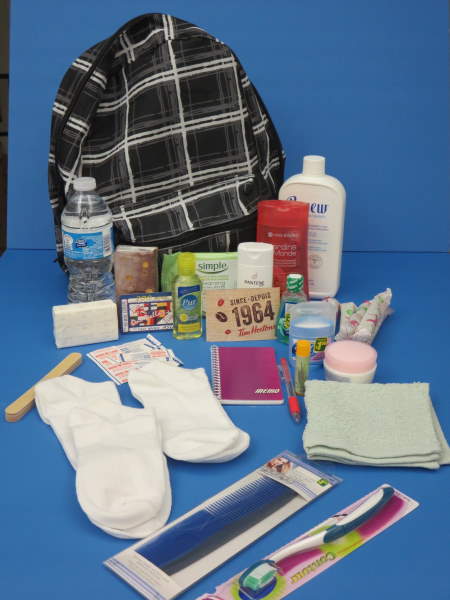 Relief Society sisters in the Toronto area provide backpacks to women being released from custody at the Brampton court. Previously, women were released with their few belongings in a garbage bag and with no support as they transitioned to their new life. Now each is given a backpack with helpful items to assist in adapting to civilian life. About two hundred backpacks are provided each year. (Malcom Warner)
Relief Society sisters in the Toronto area provide backpacks to women being released from custody at the Brampton court. Previously, women were released with their few belongings in a garbage bag and with no support as they transitioned to their new life. Now each is given a backpack with helpful items to assist in adapting to civilian life. About two hundred backpacks are provided each year. (Malcom Warner)
Community Recognition
As the number of Church members grew, with attractive meetinghouses constructed in towns and cities across the country, and as Church-sponsored cultural events, conferences, and service projects included participation by non-Mormon neighbours, the profile of the Church was raised. Visits of the Mormon Tabernacle Choir to Canada in 1962, 1967, 1969, 1975, 1984, 1986, 2007, and 2011[152] and more extensive and positive media coverage have further brought the Church in Canada “out of obscurity and out of darkness.” The Cardston Alberta Temple was designated a national historic site in 1995. Seven other beautiful and tasteful temples across Canada have further raised public awareness of the Church.
Awards and recognitions have come to the Church as Church members have reached out to help others and participate in efforts to improve their communities. For example, the Salvation Army’s Community and Family Services in Brampton, Ontario, presented an appreciation plaque to representatives of the Church in 2015. This award was in recognition of the ongoing assistance of Church members with food drives, Christmas baskets, and the Salvation Army community garden.[153]
Communities in Bloom, a Canadian nonprofit organization that encourages community beautification, has recognized the grounds of the Toronto Ontario Temple as an outstanding example. In 2006, the City of Brampton won the Canadian Communities in Bloom award for the best gardens in Canada among cities with populations of 100,000 or more, and the Toronto Temple grounds were an important reason for the win. The following year, Brampton won the International Communities in Bloom award. The temple gardens are included in bus tours for newcomers to Brampton.[154]
Conclusions
Canadian Mormons, though a relatively small part of the Canadian populace, are a strong and positive influence on society. From the earliest days of the Church to the present, Canadians have served as leaders and have contributed to the growth and development of the Church. In the latter years of the nineteenth century, Mormons came to settle in southern Alberta, where they established communities, built a network of irrigation canals, and helped transform arid grasslands into productive farms. As the years went by, many Church members migrated from southern Alberta to Calgary, Edmonton, and other cities in Canada, seeking educational and employment opportunities. This, combined with renewed missionary work and convert baptisms, resulted in congregations of Latter-day Saints being organized throughout Canada.
Wherever Latter-day Saints were found in Canada, they contributed to the progress of the country. From being honest, upright citizens and good neighbours to rising to weighty responsibility in government, science, business, and the arts, Canadian Mormons have been a positive force for good. In recent times, Latter-day Saints have increasingly reached out to provide community service and to make their voices heard on moral and ethical issues. This trend suggests that the contribution of Canadian Mormons to Canada will continue into the future, making Canada a better place to live.
Notes
[1] The intent of this chapter is to provide a composite view of the Canadian contributions and will inevitably result in some repetition, as many of the personalities featured here have been discussed to one degree or another in earlier chapters.
[2] B. H. Roberts, The Life of John Taylor (Salt Lake City: Bookcraft, 1963), 21, 28–65.
[3] Roberts, Life of John Taylor, 65–102, 130–41, 203–41, 338–45, 406–12.
[4] For more information, see chapter, Rebecca J. Doig, and W. Jack Stone, “The Alberta Settlement,” herein.
[5] Joseph Fielding, Diary of Joseph Fielding (Salt Lake City: n.p., 1963), book 1, 8 August 1837, Preston, England, typescript, 2, Church History Library, Salt Lake City (hereafter CHL), M270.1 F459f; Mercy Rachel Fielding Thompson, Mercy R. Fielding Thompson Autobiographical Sketch, 1, box 1, folder 6, CHL, MS 2737.
[6] Joseph Fielding (KWJW), Mary Fielding (KWV9-HXG), and Mercy Fielding (KWV9-HX5), www.familysearch.org.
[7] Fielding Diary, 3-4; Missionary Report, 24 April 1837, Messenger and Advocate, May 1837, 511–12.
[8] Fielding Diary, 4–10.
[9] James B. Allen, Ronald K. Esplin, and David J. Whittaker, Men with a Mission, 1837–1841: The Quorum of the Twelve Apostles in the British Isles (Salt Lake City: Deseret Book, 1992), 52.
[10] Andrew Jenson, LDS Biographical Encyclopedia, 4 vols. (Salt Lake City: Andrew Jenson History Company, 1901–36), 2:710–11.
[11] Deseret News 2013 Church Almanac (Salt Lake City: Deseret News, 2013), 114–15.
[12] “Elder M. Russell Ballard,” Ensign, November 1985, https://
[13] Mercy R. Fielding Thompson Autobiographical Sketch, 1.
[14] Mercy R. Fielding Thompson Autobiographical Sketch, 3–4.
[15] Jenson, Latter-day Saint Biographical Encyclopedia, 2:725–26.
[16] Archibald Gardner, Archibald Gardner Reminiscences, folder 1, CHL, MS 4442; History of Alvinston, Municipality of Brooke/
[17] Gardner, Archibald Gardner Reminiscences, folder 1, CHL, MS 4442.
[18] Dan Olsen, “The Nauvoo Road: A Case Study in Religious Diffusion and Landscape” (senior honours thesis, University of Waterloo, 1998), 38–42.
[19] Gardner, Archibald Gardner Reminiscences, folder 1, CHL, MS 4442.
[20] The Archibald Gardner Family, 3, 10, 17, and 24 September 2015, www.archibaldgardnerfamily.blogspot.com.
[21] Lillian Gardner Widdison, “Archibald Gardner, the Miller,” Archibald Gardner, L44V-V6T, FamilySearch, www.familysearch.org.
[22] History of Alvinston, Municipality of Brooke/
[23] Gardner Village History, Gardner Village, http://
[24] Joseph Horne, Reminiscences and Diary, 1, CHL, MS 1473.
[25] “The Hales Are Converted to Mormonism,” Stephen Hales, LKVB-S7Y, www.familysearch.org.
[26] Mary Isabella Hales Horne, “Mary I. Hales Horne Testimony of Sister M. Isabella Horne” (n.d.), CHL, MS 5302; Joseph Horne, Reminiscences and Diary, 1.
[27] Mary Isabella Hales Horne, “Testimony,” 2.
[28] Jenson, LDS Biographical Encyclopedia, 1:806–7.
[29] Jenson, LDS Biographical Encyclopedia, 4:187.
[30] Ella Mae Turley Judd, Theodore Turley Biography and Autobiography, folder 1, 1–12, CHL, MS 7661.
[31] Allen, Esplin, and Whittaker, Men with a Mission, 56–58, 129–30.
[32] List of Members in Mersea Essex Branch, William Burton Papers, folder 19, CHL, MS 1508; Deseret News 2013 Church Almanac, 155.
[33] Allen, Esplin, and Whittaker, Men with a Mission, 20–53.
[34] Allen, Esplin, and Whittaker, Men with a Mission, 3–4, 56–57, 135–44, 172, 181, 232–33, 301.
[35] Allen, Esplin, and Whittaker, Men with a Mission, 130–31, 162.
[36] Biographical Sketch, Alexander Wright Papers, 1838–1876, folder 3, n.d., CHL, MS 8284.
[37] Joseph Smith Mulliner, The Scottish Mission, folder 1, 1–4, CHL, MS 4389; Andrew Jenson, Historical Record, (Salt Lake City, Utah: Andrew Jenson, Publisher, 1899), vol. 6, 348-49.
[38] Artemus Millett, “Reminiscences,” [ca. 1855], holograph, CHL, MS 1699.
[39] Keith A. Erekson and Lloyd D. Newell, “The Conversion of Artemus Millet and His Call to Kirtland,” BYU Studies 41, no. 2 (2002): 92.
[40] Parnell Hinckley, “Events in the Life of Ira Nathaniel Hinckley, 1828–1904, Pioneer, Churchman, Rancher,” 1-4, CHL, 270.1 H6592h.
[41] Hinckley, “Ira Nathaniel Hinckley,” 5–9.
[42] Brigham Young to Ira Hinckley, 12 April 1867, cited in Hinckley, “Ira Nathaniel Hinckley,” 9–10.
[43] Hinckley, “Ira Nathaniel Hinckley,” 10–11.
[44] Ira Nathaniel Hinckley to George A. Smith, ca. November 1867, in Hinckley, “Ira Nathaniel Hinckley,” 11–12.
[45] Hinckley, “Ira Nathaniel Hinckley,” 21–40.
[46] Deseret News 2013 Church Almanac, 117.
[47] Jane Snyder Richards, Jane S. Richards Autobiographical Sketch, 1881, CHL, MS 11741.
[48] Centennial Birthday Anniversary of Jane Snyder Richards, 1823–1923, January 31, 1923, CHL, M270.07 R516c 1923.
[49] Janet F. Jeffery, History of the James Lake Jr. Family (Roy, Utah: J. F. Jeffery, ca. 1990), 20-26, 30-31, 34-43, 49. James Lake is an ancestor of the author.
[50] “A History of Daniel Wood” and “Life Sketch of Daniel Wood,” Daniel Wood (LCMV-2PS), www.familysearch.org; Henry Dinwoodey Moyle (KWCF-FBY), www.familysearch.org.
[51] William Draper, Life of William Draper, 1, 14, CHL, MS 22036.
[52] Betty G. Spencer, “American Fork,” Utah History Encyclopedia, http://
[53] “Rambling Reminiscences of Margaret Gay Judd Clawson,” and Family Tree, Margaret Gay Judd (KWJC-2N9), www.familysearch.org; Deseret News 2013 Church Almanac, 121.
[54] Sarah Studevant Leavitt, History of Sarah Studevant Leavitt, copied from her history by Juanita Leavitt Pulsipher, June 1919, 5–7, CHL, M270.07 L439h 1969. See also Andrea Ventilla, “’Like Fire in My Bones’: Sarah Sturtevant Leavitt,’ in Richard E. Turley Jr. and Brittany Chapman, eds., Women of Faith in the Latter Days, 1:155–56, which claims the Leavitt family was baptized before moving to Kirtland. Note that the surname is spelled in various ways, such as Sturtevant, Sturdevant, and Sturdevent, in various sources.
[55] Leavitt, History, 7–34, 40–41. See also Sarah Sturtevant Leavitt Monument, http://
[56] “Sarah Sturtevant Leavitt Life Story,” Sarah Sturtevant Leavitt, KNC6-Y5W, www.familysearch.org.
[57] Sarah Sturtevant Leavitt Monument, leavittfamilies.org/
[58] Sarah Sturtevant Leavitt, “Life Sketch,” Sarah Sturtevant Leavitt, KNC6-Y5W, www.familysearch.org.
[59] Thomas Rowell Leavitt, KWN5-DMX, www.familysearch.org.
[60] Marriner W. Merrill Reminiscences, 1988, 5, 8–9, CHL, MS 1785 2.
[61] Marriner W. Merrill Reminiscences, 1988, 9–13, CHL, MS 1785 2.
[62] Melvin Clarence Merrill, ed., Utah Pioneer and Apostle Marriner Wood Merrill and His Family (Marriner Wood Merrill Heritage Committee, 1980), 33–41.
[63] Merrill, Utah Pioneer and Apostle Marriner Wood Merrill, 56–87.
[64] Deseret News 2013 Church Almanac, 127.
[65] Grant L. Nielsen, Joseph Russell, Miramichi Shipbuilder and Financier (Brossard, Quebec: Grant L. Nielsen, 1980), 1–12, 18, CHL, M270.1 R964n 1980.
[66] Wilford Woodruff’s Journal, 1838–1898, vol. 3 (1 January 1846–31 December 1850), ed. Scott G. Kenney (Midvale, UT: Signature Books, 1983), 469–72, CHL, M270.1 W893wiL.
[67] Nielsen, Joseph Russell, Miramichi Shipbuilder, 25–33, CHL.
[68] Nielsen, Joseph Russell, Miramichi Shipbuilder, 34-35, CHL.
[69] “Plaque dedicated in honor of convert Joseph Russell,” Church News, 22 October 2005, 7.
[70] “The Palliser Expedition,” Events of National Historic Significance, Parks Canada, www.parkscanada.gc.ca.
[71] B. Y. Card, “Charles Ora Card and the Founding of the Mormon Settlements in South-Western Alberta, Northwest Territories,” in Mormon Presence in Canada, ed. Brigham Young Card and others (Edmonton: University of Alberta Press: 1990), 77–107; Byron C. Palmer and Craig J. Palmer, “Mormons in Western Canadian Agriculture, From Irrigation to Agribusiness,” in Mormon Presence in Canada, 234–59.
[72] Howard Palmer, “Polygamy and Progress: The Reaction to Mormons in Canada, 1887–1923,” in Mormon Presence in Canada, 109–19.
[73] See Doig and Stone, “The Alberta Settlement,” herein.
[74] “Irrigation in Alberta,” Government of Alberta, Agriculture and Forestry, www1.agric.gov.ab.ca/$department/
[75] See Rebecca J. Doig and Daniel H. Olsen, “Crossing the 49th Parallel: Community, Culture and Church in a Canadian Environment,” herein.
[76] Village of Stirling, National Historic Site of Canada, Parks Canada, www.pc.gc.ca.
[77] Palmer and Palmer, “Mormons in Western Canadian Agriculture,” in Mormon Presence in Canada, 236–39. Jesse Knight visited Canada to establish his business investments, but did not actually live there. His son Raymond, for whom the town of Raymond was named, moved there with his family in 1901 and oversaw his father’s investments. Census of Canada, 1906, Alberta, Alberta district (#18), subdistrict 11B, and Census of Canada, 1911, Alberta, Medicine Hat district, Raymond #66, www.automatedgenealogy.com.
[78] William G. Hartley, “Mormon Sugar in Alberta: E. P. Ellison and the Knight Sugar Factory, 1901–17,” Journal of Mormon History vol 23 (Fall 1997): 1–25; History of Taber, The Town of Taber, http://
[79] Palmer and Palmer, “Mormons in Western Canadian Agriculture,” in Mormon Presence in Canada, 244–47.
[80] Palmer and Palmer, “Mormons in Western Canadian Agriculture,” 244–47.
[81] “Asael Palmer,” Edmonton Journal and Calgary Herald, 5 July 2005, Canada.com, http://
[82] Palmer and Palmer, “Mormons in Western Canadian Agriculture,” 247–49; O. William Asplund, interviewed by Roy A. Prete, 5 January 2016.
[83] “Ellison Milling Company,” Edmonton Journal / Calgary Herald, 8 August 2005, http://
[84] Gregory P. Christofferson, “Correspondence and Documents regarding Ellison Milling’s Role in Providing Welfare Wheat to Latter-day Saints in Post-War Europe, September 1947–October 1949,” correspondence with various General Authorities and Morris H. Ellison and Reed C. Ellison, folder 1, CHL, MS 13379.
[85] Palmer and Palmer, “Mormons in Western Canadian Agriculture,” 249–50.
[86] The Governor General of Canada webpage, Kenneth F. Nielsen, CM, PhD, recipients of the Order of Canada, www.gg.ca/
[87] G. Homer Durham, N. Eldon Tanner: His Life and Service (Salt Lake City: Deseret Book, 1982), 36, 58, 62, 70–71; Calgary Herald, 6 January 1937, cited in Durham, N. Eldon Tanner, 72–73.
[88] Durham, N. Eldon Tanner, 140–64; Calgary Albertan, 6 December 1958, cited in Durham, N. Eldon Tanner, 163.
[89] Durham, N. Eldon Tanner, 45, 114–38, 167, 182, 192, 198, 254, 266, 274.
[90] Eugene E. Campbell and Richard D. Poll, Hugh B. Brown: His Life and Thought (Salt Lake City: Bookcraft, 1975), 44–48, 52–65, 75–90, 95, 100–102, 106–9, 114–16, 120, 137–40, 144–46, 158–64, 185, 189–91, 208, 217.
[91] Campbell and Poll, Hugh B. Brown, 219, 233, 239–40, 252–53, 277–78, 280–81.
[92] Anita Thompson, Stand as a Witness: The Biography of Ardeth Greene Kapp (Salt Lake City: The Church of Jesus Christ of Latter-day Saints, 2009), 11–24, 95–98.
[93] Biographical Information, Ardeth G. Kapp, Ardeth G. Kapp Presidency and Board, 1984–1992, Young Women Biographical Sketches, box 1, folder 2, CHL, CR 13 211.
[94] Thompson, Stand as a Witness, 232–34, 272–73.
[95] Thompson, Stand as a Witness, 113–50, 211–15, 245–46, 262–23.
[96] Thompson, Stand as a Witness, 1–6, 268–73.
[97] Thompson, Stand as a Witness, 319–48, 363–72.
[98] “Elaine L. Jack,” Civic and Religious, Relief Society General Board Biographical Profiles and Portraits, box 1, folder 1, Elaine Jack, CHL, CR 11 321.
[99] “Elaine L. Jack, 1990–,” Elect Ladies, 203, Relief Society General Board Biographical Profiles and Portraits, box 1, folder 1, Elaine Jack, CHL, CR 11 321.
[100] “Epilogue, The Roots and the Vision, 1990–,” Relief Society General Board Biographical Profiles and Portraits, box 1, folder 1, Elaine Jack, CHL, CR 11 321.
[101] “New Temple Presidents,” Church News, 20 September 1997, 13; Joseph E. Jack, Historical Positions, Church Directory of Organizations and Leaders (CDOL), last updated 11 December 2009, cdol.lds.org.
[102] “Elder Jacob de Jager Dies at 81,” Deseret News, 29 February 2004; Thomas S. Monson, “Decisions Determine Destiny,” New Era, November 1979, 4; “Jacob de Jager,” https://
[103] “Elder Alexander B. Morrison of the First Quorum of the Seventy,” Ensign, May 1987; Alexander B. Morrison, https://
[104] Mormon Inner City Project Blesses Lives of Thousands,” http://
[105] “Contributors,” in Window of Faith: Latter-day Saint Perspectives on World History (Provo, UT: Religious Studies Center, 2005), ed. Roy A. Prete, xvii.
[106] Library of Congress search.
[107] Appraisal of Roy A. Prete, 20 June 2016.
[108] Deseret News 2013 Church Almanac, 154, 176.
[109] See chapters herein for details. At least two Canadians served as Mission Representatives of the Council of the Twelve and the Council of the Seventy in the period, 1972–74, before this office was integrated with the office of Regional Representative of the Twelve. Garry Ursenbach [a former Mission Representative], telephone conversation with Roy A. Prete, 31 March 2017; Garry Ursenbach, email to Roy A. Prete, 2 April 2017.
[110] South Africa Johannesburg Mission Record of Missionaries, 1927–1974, box 2, vols. 2–3, CHL, LR 8452 34; South Africa Mission History, CHL, MS 16647; H. Dean Garrett, “South Africa,” in Encyclopedia of Latter-day Saint History, ed. Arnold K. Garr, Donald Q. Cannon, and Richard O. Cowan (Salt Lake City: Deseret Book, 2000), 1160–61.
[111] “Pioneer of LDS Missionary Work in Africa Killed in Orem Accident,” Provo Daily Herald, 6 December 2009, http://
[112] David K. Elton, “Political Behavior of Mormons,” in Mormon Presence in Canada, 268–69.
[113] Elton, “Political Behavior of Mormons,” 267–77; Jim Hillyer (politician), https://
[114] Howard Palmer, “Polygamy and Progress: The Reaction to Mormons in Canada, 1887–1923,” in Mormon Presence in Canada, 124–25.
[115] Campbell and Poll, Hugh B. Brown, 54–64, 70.
[116] John “Jack” Archibald Armstrong, Obituary, Toronto Star, 3 January 2011, http://
[117] “President’s Dream Colloquium on Obedience and Disobedience: Taking Action on Climate Change, Spring 2015, Speaker: John Borrows,” Simon Fraser University, Graduate Studies and Postdoctoral Fellows, http://
[118] Brigham Young University Religious Studies Center, David B. Galbraith, rsc.byu.edu/
[119] Robert B. White, Q.C., Chairman, Robert B. White, Q.C. & Company, www.whiteqc.com/
[120] Robert B. White, CDOL; “Sustaining of Church Officers,” Ensign, May 2001, 20; “Sustaining of Church Officers,” Ensign, May 2007, 4.
[121] Ian MacLeod, “Dr. Tofy Mussivand: From Goat Herder to Scientific Pioneer,” Ottawa Citizen, 16 November 2010; Tofy Mussivand, https://
[122] University of Ottawa Heart Institute, Tofy Mussivand, https://
[123] Daren Heyland, MD, Critical Care Nutrition at the Clinical Evaluation Research Unit (CERU), Kingston General Hospital/
[124] Information compiled by Rob and Becky Olsen. See “Crossing the 49th Parallel,” in this volume.
[125] Larry Carter, “Karl Tilleman: An Example of Determination and Endurance,” canada.lds.org, 18 January 2013.
[126] Richard Bak, “Remembering Gordon Strate, the Red Wing Who Never Scored a Point,” Detroit Athletic Co., Detroit Sports History: Tigers, Red Wings, Lions and Pistons, posted 8 April 2013, https://
[127] Colby Cosh, “A Prairie Football Phenomenon: A Small Alberta High School Keeps Punching above Its Weight,” Macleans, 2 November 2011.
[128] Ray Knight, The Hall of Fame 1981, Canadian Professional Rodeo Hall of Fame, www.canadianprorodeohalloffame.com/
[129] “About Mary Lambert,” Mary Lambert Productions, www.marylambertmusic.com.
[130] Simon Dewey, Deseret Book biographical sketch, https://
[131] Richard Comely, “About Me” and “Why I Am a Mormon,” https://
[132] Carol Reid Burr and Roger K. Petersen, Rose Marie Reid: An Extraordinary Life Story (American Fork, UT: Covenant Communications, 1995), 5, 32–33, 86.
[133] Reid and Peterson, Rose Marie Reid, 35, 51–59, 97, 99, 155, 168–69.
[134] William Ray Alston, “Mother of Canadian Scouting,” in Women of Faith in the Latter Days, vol. 3, ed. Richard E. Turley and Brittany A. Chapman (eBook edition).
[135] Alston, “Mother of Canadian Scouting.”
[136] “Scouting in Canada,” http://
[137] “Scouting in Canada”; Canada, Facts and Statistics, Newsroom, http://
[138] Canada, Facts and Statistics, http://
[139] Ardis E. Parshall, “Lethbridge, Alberta: ‘Ye Shall Obtain Riches . . . to Feed the Hungry,’” 25 February 2010, www.keepapitchinin.org.
[140] Christofferson, “Ellison’s Milling’s Role in . . . Post-War Europe,” correspondence with various General Authorities and Morris H. Ellison and Reed C. Ellison, folder 1, CHL, MS 13379.
[141] “First Presidency Calls Special Fast day to Assist Starving Victims,” Church News, 20 January 1985, 2; Gerry Avant, “Fast Benefits Famine Victims,” Church News, 3 February 1985, 12; Gerry Avant, “Africa Fund Fast: ‘Gratifying Results,’ Church News, 10 February 2015, 5.
[142] Lynn A. Rosenvall, “The Transfer of Mormon Culture to Southern Alberta” (Mormon Historical Association conference, 29 June 2012, Calgary, Alberta, Plenary session address, transcript, 7).
[143] Linda Davis, “Members Respond to the Flooding in High River, Alberta,” Canada LDS website, July 2013, www.canada.lds.org; Darrell Palmer, “Floods of Mercy,” Canada LDS website, August 2013, www.canada.lds.org.
[144] Joe and Joan Hall and Linda Ripplinger, “Joining Hands in Community Service,” 16 December 2013, Canada, http://
[145] Linda Davis, “Calgary,” herein.
[146] Donna Mazzei, “Little Dresses for Africa Bring a Special Spirit to Youth,” 12 January 2014, http://
[147] See George K. Jarvis and Jonathan A. Jarvis, “A Distinctive Way of Life: Family, Health, Education, and Employment,” herein.
[148] “Ken Kyle, Ron Draper Health Promotion Award,” Canadian Public Health Association (CPHA), www.cpha.ca/
[149] Dolina Smith, email to Carma Prete, 7 November 2016; 38th Parliament, 1st Session, proceedings of the Standing Committee on Justice, Human Rights, Public Safety and Emergency Preparedness, 21 April 2005, www.parl.gc.ca/
[150] “Mormon Women Help Incarcerated Mothers Connect With Their Children,” Newsroom Canada, 6 March 2013, www.mormonnewsroom.ca/
[151] “Homeless Choir Inspires Audiences Worldwide,” Good News Network, 17 June 2006, www.goodnewsnetwork.org/
[152] See Ruth Yates, “British Columbia,” Walter Meyer, “Edmonton and Northern Alberta,” Helen Warner, “Ontario,” and G. Eric Jarvis, “Quebec,” herein.
[153] “Mormons Receive Appreciation Plaque from Salvation Army in Brampton,” Newsroom Canada, 23 March 2015, www.mormonnewsroom.ca/
[154] Helen Warner, email to Carma Prete, 3 November 2016.
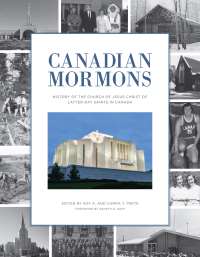
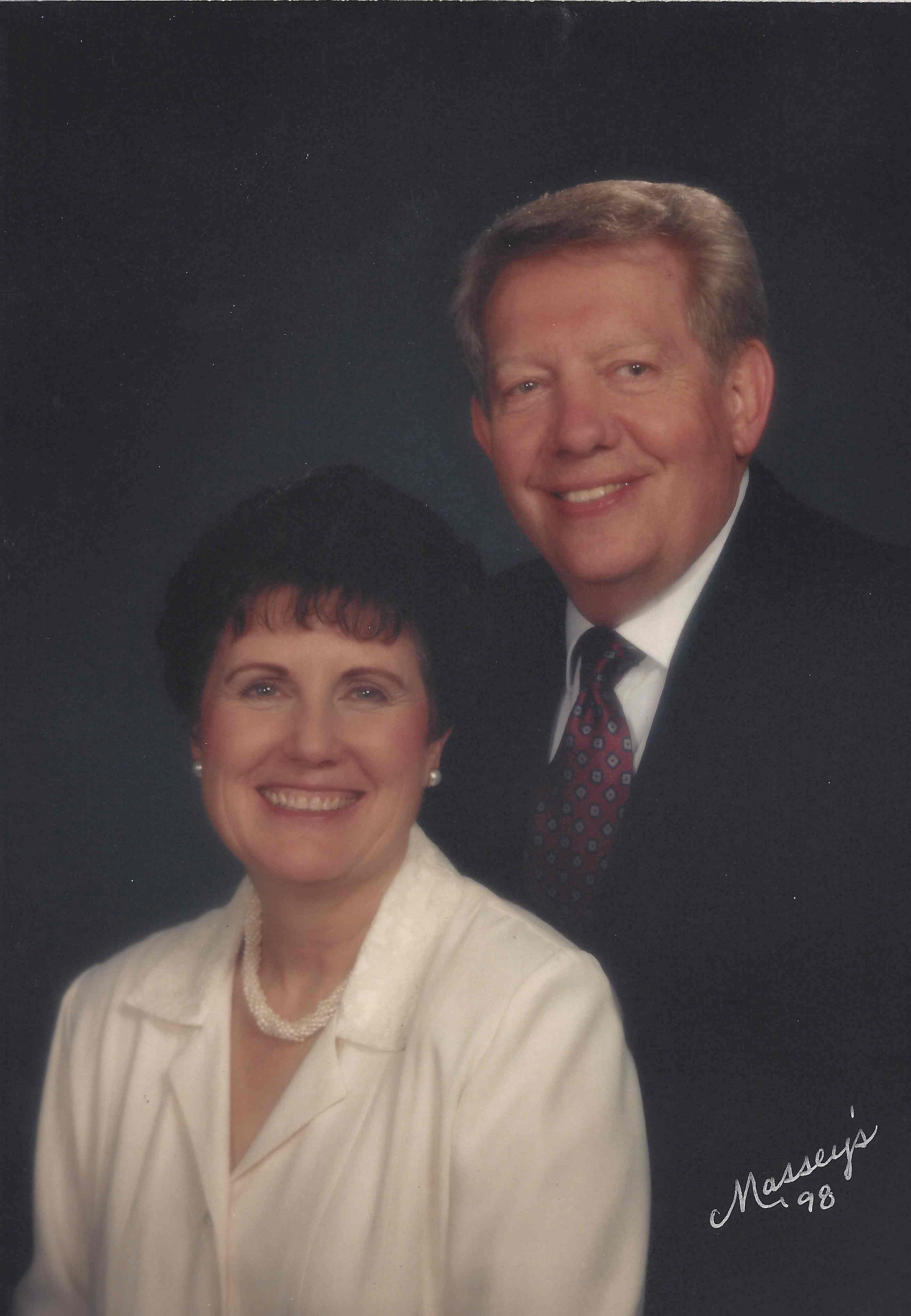 Dale and Laura LeBaron. (Laura LeBaron)
Dale and Laura LeBaron. (Laura LeBaron)